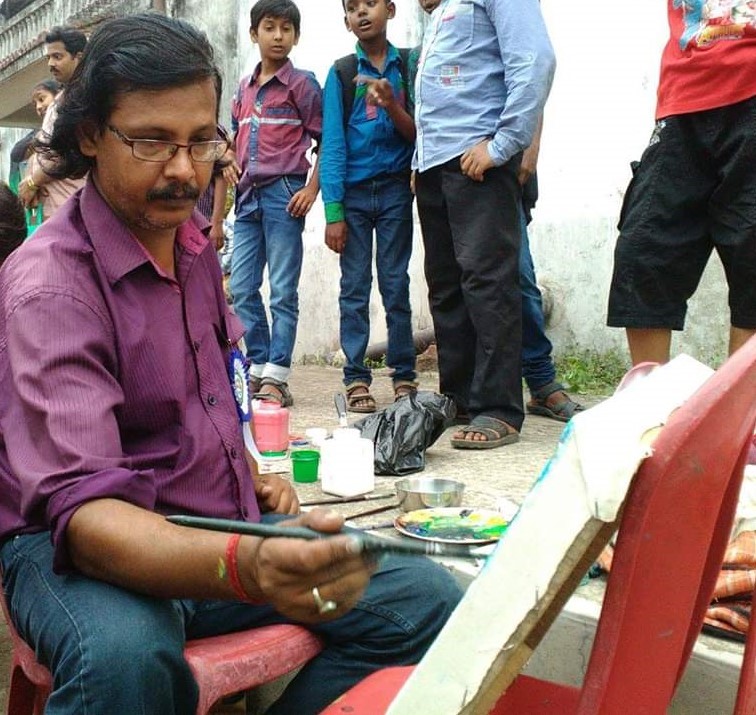
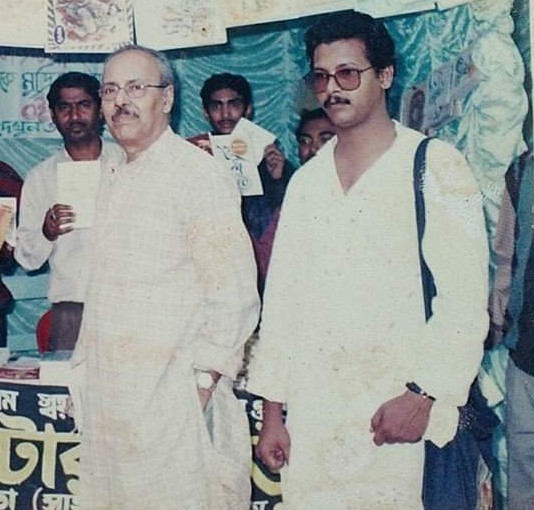
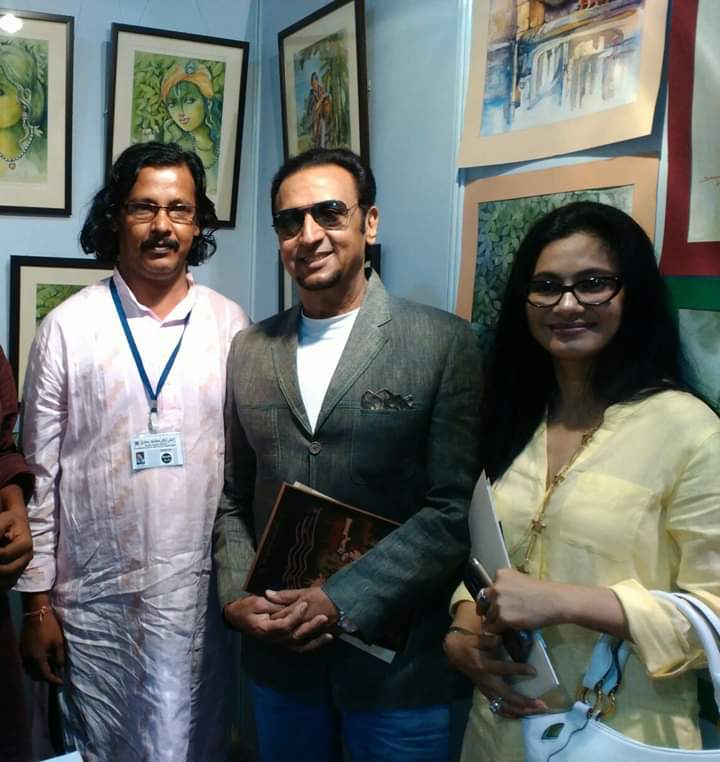
‘Are you aware of the syllabus?’ The Dean raised his tired superior eyes.
‘Yes, I do. It is bad.’ Replied the man in mid-thirties.
‘Your view on the quality of the syllabus matters only in the canteen over a cup of tea. Not beyond that.’ Said the Dean.
‘But it matters a lot to the students in the class. Because they have a future to live. And I care for that.’ The young man said in toneless arrogance denying the authority of the Dean.
‘I see! But the trouble is, you are being paid for what we want you to teach. Not what you want to teach. Don’t you think, it is reasonable?’ The dean was growing impatient. He removed his black rimmed spectacle and put it down on the mahogany desk.
‘Well, I take my salary for teaching art, not for following orders.’ The young man looked away indifferently.
‘Then we have a conflict here. I do not think, I can permit you to keep on rambling about things not relevant to the course.’
‘I can understand. Not knowing the language turns even the Bible or Veda into ramble. In this case it is Art. You find me rambling because you are yet to learn the language of art. You should have attended a few classes of mine. But sadly, you missed it forever. Here is my resignation.’ The young man stood up calmly placing the envelope on the desk.
The dean blinked puzzled and angry. The young man left.
Well, that is the story of Sharat Shaw, an artist, who never lived by the syllabus of life as most people do. At the age of three, when most kids played with toy trains or balloons, Sharat Shaw scrapped clay from the riverbed and molded men, women, animals and gods!
When in his teens, he was busy giving life to molds of clay, a cousin told him that he was learning to paint. ‘Is it more interesting?’ He wondered. And soon he found himself scrawling across the white pages of his notebooks.
Simple, it may sound, but the journey had not been easy. Though he had been guided by professional artists of the locality, yet fortune did not smile too fast. He wanted to study art in the government college of art in Kolkata. He appeared for the entrance exam but could not get through. He was rejected.
No way! He resolved to make it to another art college. Government college of art was not the end of the world. He went to Shantiniketan. But luck failed him again. His name did not appear in the list of selected candidates. He applied for graduation in Rabindra Bharati university. Rejection blocked him there too. Finally, he came to terms with the reality that a graduation from the Art college was not happening soon.
But passion cannot be assailed by entrance exams. The young Sharat Shaw went ahead painting and exhibiting his artworks. Soon, his watercolor paintings captured the fancy of art lovers. Publishers approached him for books on how to paint. Series of books got published. Even this day, students across the country refer his books to learn how to draw. The schools and colleges wait for his new publication. Today, he is an esteemed name in the art circle.
But, a vacancy remained. His dream of holding a degree from the Government college of art was not fulfilled. When he hit the middle age, a new course was introduced in the evening for those who wanted to catch up late. And Sharat Shaw appeared as student. The faculties were puzzled. They asked, ‘Why did you enroll?’ He replied, ‘You know what? I can drive faster than most, but I need the damn license!’
The story in the beginning is just a flash to illuminate some aspect of the man and the artist. He tried a few jobs before settling in art as a profession. He was a lecturer in an art college where the authorities wanted him to stick to the syllabus. He did not believe in one. He felt syllabus meant boundary. And creativity lived outside the boundary. He left the job of lecturer.
He worked as art director in Ramoji Film City. There too, his views and ways could not be contained by the strictures of the routine life. He left that too for the hunt of freedom of expression and passion.
He is still painting in a mad frenzy. He is teaching the budding artists about the boundless spirit of art. He is still living life beyond syllabus. For him, life is too big and wild for drawing a border around it.
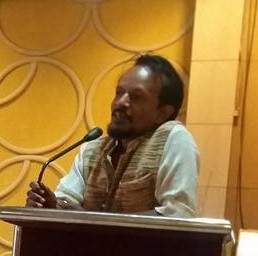


‘One more tea.’ He waved at the waiter.
The young waiter brought a cup of tea and placed on the table before him. He gazed at the translucent brownish liquid in abstraction.
The pressing hand on his shoulder broke his reverie. “I have a surprise for you. We must celebrate this evening.” Said his friend slumping on a chair across the table.
He was happy to see his friend. They often met at this café after the day’s grind for the hunt of destiny.
He smiled in mischief. ‘I too have a surprise to give. But you go first.’
His friend gazed at him for a long moment for the effect of suspense, ‘The promotional content you created for our company has been a grand hit. They want to sign an annual contract for their entire product range! I had a talk with someone from the advertising section during lunch and came to know.”
‘They liked my work, is it?’ He said with an ironic smile.
‘Yes! Do you realize? You are going to get a huge contract; and a name in the field of industrial advertising.’
He nodded but said nothing. He sipped the lemon tea and sat in silence.
‘What is the matter?’ His friend looked at him with concern.
He shrugged. ‘Nothing serious. By the way, how much will they pay for the assignment?’
‘I do not know, but a good sum, better than the last payout.’ Said his friend.
Suddenly, he seemed to wake up with a broad smile. ‘I shall not do it.’
‘What? Are you in senses? What are you talking?’
He nodded firmly. ‘Yes, I am. I shall not capture photos of those damned machines anymore. All that cut and paste in computer and then thinking up phony phrases for machines looking like dumbos. No. Enough! No more.’
‘What will you do then?’
‘I shall paint.’ He said plainly.
‘Paint what? Buildings, walls, roofs?’
He shook his head slowly, ‘No. Canvas.’
‘You mean you will become an artist?’ His friend almost spilled his tea over the table.
He nodded again. ‘I am going to paint. I shall be an artist. I must respond to my true calling.’ He uttered firmly.
‘And when did you hear this cosmic call?’ His friend now teased.
‘Time does not have to testify true calls. One must respond to it, as soon as it rings.’
Well, that is how one fine evening, Sonjaye Maurya forsook his thriving career of Industrial advertising for the sake of the canvas. Well, it was not true that he never painted before. Painting was his love since childhood. In fact, he graduated from Sir J. J. Institute of Applied Art in Commercial Art and Photography. But eventually, he spent considerable number of years in Industrial advertising until he responded to his true calling.
It was not easy. Fortunately, he found his wife and son beside him when he decided to pick up the brush. Their unstinted support fueled his journey as an artist. How to keep the kitchen running did not fetter his passion.
A journey begins but with a single step. True. But the million steps on the way are no easy either. Sonjaye approached dozens of people with influence in the world of art as he took up painting. But the response was cold, often none at all. But greater was the disappointment, stronger grew his resolve. He decided to carve his own path, if destiny did not offer him one.
And he did that.
Today, he is a respected name in the world of art. Countless accolades came on his way.
His works have a mysterious quality, a magical touch that makes them stand apart from the works of other contemporary artists. Each of his paintings carry a message; may it be Buddha or a landscape.
Perception of human feelings in different realms of life often rules his themes. His vibrant palette of color splashes over the fabric of fantasies and dreams. He says that a painting is a dream that you see on an empty canvas.
He does not restrict himself to any medium. Seamlessly walking through acrylic, pencil, charcoal or water on paper, he feels that a painting decides which medium it wants. Hence, in his view, sticking to a medium is unfair for a painting.
‘Style is slavery! Technique is prison,’ Says Sonjaye Maurya, ‘And art is freedom.’
His paintings explore the nuances of existence and bring forth the spark of joy, sorrow, passion and other realities of life in a manner that provokes the viewer to think.
Sonjaye did alter his profession from being an Industrial photographer to an artist. He found glory and plenty of recognition on the way. But the memory of the struggle of his early days never faded into oblivion. He knows what it means to be a newcomer in the field of art. The ruthlessly unfair treatments kill most spirits right in the beginning. That prompted him to take up another mission in life.
He founded ‘Sonjaye Maurya Art World’ and ‘Creative Art Affairs’; initiatives to appreciate and promote young and upcoming artists. The groups are imbued with Futuristic vision and trend setting goals. His goal is to build a platform for the young talents to display their works for a critical audience.
He quotes from ‘Lust for Life’, the book on Van Gogh’s life. ‘The artist who cannot survive the grind of fate, is not worth saving.’ And then he looks away in abstraction before muttering, ‘This does not mean, we have to join hands with fate and make their lives more difficult.’


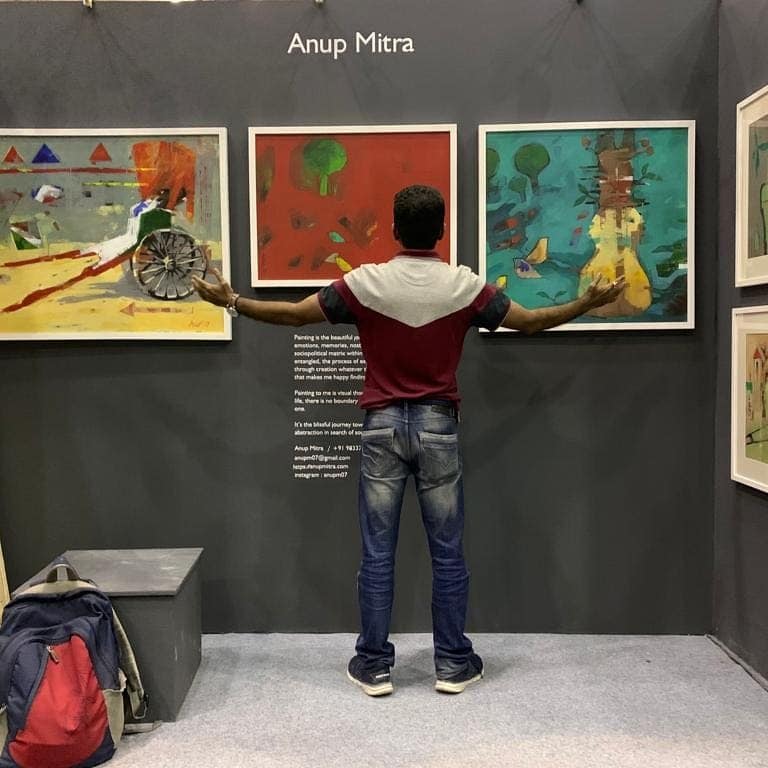
‘You are back!’
He was trying to enter home quietly on tiptoe. His father would be busy catching up with the unread articles in the newspaper delivered in the morning. He hoped for an undetected arrival for himself.
But his hope of returning home in secret was shattered at the voice of his father.
He replied mutely, ‘Yes I am back.’
‘Did you check the list?’ Eagerness and optimism resonated in his father’s tone.
He removed the shoes and arranged them neatly lingering at the shoe-rack for a long moment as if it called for the finest sense of aesthetics.
Now his father sounded impatient, ‘I am asking you! Did you check the list?’
He turned to face his father slowly but did not meet his eyes. ‘Yes, I did.’
‘And?’ His father demanded.
‘Well, my name is not there in the list.’ He mumbled.
‘What? You mean you did not even secure a low rank? Ridiculous!’
He remained silent gazing at the tiled floor.
His father shook his head in agony and turned away muttering, ‘You are not even capable of doing a polytechnic in engineering! I do not know how you will sustain yourself when you grow up! Everybody got to earn their bread, you know!’
He waited a while until his father stopped noticing his presence. Then he quietly walked into his room at the corner of the house. He was not sad. His eyes were not holding an impending tear of sorrow. He was relieved; almost jubilant! In fact, he was holding a vague smile too on his lips. Because, finally, the ghost of engineering left his life. In reality, he did not even go to check the list of candidates shortlisted for the course of Engineering Polytechnic. He lied to his father that his name was not there. He did not even know. Neither did he bother.
He knew only one thing for sure. He must learn art. After passing his exams of standard twelfth, he kept appearing for the entrance exams of various art colleges in the city. But as fate had it, he could not crack any of the exams. Finally, he took up bio science for graduation. But still, the catcalls from the world of art never ceased. When he became already a graduate in Bio Science, fortune smiled. And soon he walked into the campus of Rabindra Bharati University for a second graduation but in fine arts.
And then there was no looking back. After graduation, he did his masters from Shantiniketan and emerged in flying colors as one of the top five students. In the Academy of Fine arts, his paintings were exhibited time and again even when he was a student in the art college. Several awards came on his way.
Since then, he had held countless exhibitions across the globe. Even if he could have earned a luxurious living through painting, he chose to stay associated with the film industry. For diversion of spirit and to keep his art disconnected from commercial influence, he attached himself with one of the leading media houses of Mumbai.
He believes in painting the truth overlooked by the people. He does not feel happy painting a flower like a flower as if captured by an expensive DSLR camera. He says it is the job of the camera, not the artist. An artist must paint the fragrance of the flower or the sharpness of its thorns.
Another fascination of him is Nostalgia. An indomitable yearning to return. That is why in his paintings, man-pulled rickshaws and kites come back again and again. He cherishes childhood memories of running through the lanes after a falling kite in red or yellow.
In an international exhibition, an old woman came looking for him. When she met him, she said, ‘Not you! I want to meet the artist.’ He, in his characteristic demure tone, said, ‘I am the artist.’ The old lady took a few steps back to have a good look at him. And then exclaimed, ‘Strange! I saw your paintings in the catalogue and thought that the artist must be an old man! Are you not too young to admire the past?’
He laughed. ‘No. Everyone has a past. Even a toddler.’
His paintings came with spirits of various phases of his life. He says that an entire series painted many years ago was reflection of the sense of loss he endured out of a broken affair.
When Romartika Correspondent spoke to him, he said, ‘You know, people look at my paintings. They appreciate my art and even collect them at good price. But I rarely see them smiling when they stare at the images. They look sad.’
Our correspondent said, ‘Yes. Your paintings are celebration of melancholy.’
He reflected for a moment. ‘I think, even sorrow contains happiness in its womb.’
Our correspondent teased him, ‘Melancholy is a charming element in an intellectual. How about marriage? Are you not going to settle in the arms of someone?’
He smiled, ‘May be. May not be. After all, art chose me. I belong to art. Should I invite another lover in my life?’



Author - Saikat Baksi
Suddenly she was conscious. She lifted the brush off the canvas and dipped it into a bowl of water. The dripping paint dissolved into it quickly resulting in a swelling cloud of red pigment. She turned slowly.
‘How long are you watching me paint?’ She asked smiling.
‘For a lifetime.’ Said the young man to his newly married wife.
‘And you will keep watching like this, standing in silence?’ Said she.
He nodded; his gaze fixed on the canvas.
‘But I shall paint for the entire lifetime!’ She smiled.
‘I want you to.’ He said in abstraction, still looking at the half-done painting on the easel.
She went back to her brush and thought aloud, ‘I have to quickly finish painting this section before the naughty boy wakes up.’
Her husband said nothing.
After a long moment, he said, ‘Your grandma was a good artist. She was a disciple of Abanindrananth Thakur. But…’
Her brush halted. She looked at him, ‘But?’
‘But she could not make it. Right? Her passion was replaced by her professional demand as a matron in the hospital. And that is why you are here today. You came to earth and survived. She sacrificed art for the sake of survival of her bloodline.’
She was taken aback. ‘You are right. But why are you saying this?’
He stared at her squarely. ‘You will not be another victim. You will make it. You will go to the art college and get a formal training in this field.’
She began to laugh. ‘Come on! I am already a science graduate. Isaac Newton and Vincent Van Gogh do not blend well. I do this for pleasure. That is all. Moreover, now, after having a baby who enjoys only nocturnal adventure and sleeps through the day, I can not afford such luxury of going to some college. Who will take care of the household?
‘We shall manage. Life is never easy for an artist. But one must face life head on.’ I shall fill up the form for admission. The sessions will begin soon.
Such was a fragment of Sulagna’s journey as an artist. Even if classical music was her early companion since the age of seven, art occupied the centre stage soon. The eyes of the Goddess Durga captured her fascination and she kept sketching them over and over.
Soon, her creative spirit began to expand and engulfed the whole existence. Beside her studies, she fervently indulged in painting. She treasured the old works of her grandma. Often, she opened a battered file and looked at the crackling yellowed papers.
Her husband’s wish for her to attend the art college proved right. She emerged with flying colours. She secured the top rank in her batch. And then she began her journey as a professional artist. Countless exhibitions stood testimony to her success. Her paintings were highly admired by connoisseurs of the world of art.
Commercial success too followed and put a stamp of approval to her genius.
Ironically, when asked about setbacks, Sulagna finds it difficult to get an answer. After groping for words, she says, ‘Not really. I was once told in the art college that I should have secured 3 out of 10 instead of 8. I never found it paralysing for my spirit. In fact, it injected even more ferocity to my passion to come up with something new. I feel, every rejection, every setback is a step forward.’
Even the rejection of one of her paintings by Bombay society of art did not upset her much. She says it made her reflect further. And such reflection is not to align with what the art society is looking for but to break open a new window in her creative mission.
Well…she is in a hurry. Because she says that life is short. And she has too many paintings to complete. Minor issues and setbacks of life must be put aside. Otherwise, the journey of a creative soul would remain incomplete for no valid reason. In fact, there cannot be any valid reason for creativity to take a backstage.
Over a period, she developed her unique style of painting. Significant part of each of her paintings is composed of her signature. She says that she projects her inner world onto the papers and canvasses. The paintings hold her own reflections. Hence, they carry her signature all over.
After all, in Hindi, the word, Sulagna, means smouldering. Burning slowly without fire. Her paintings are born out of that eternal singing of life. Hence, each of her paintings is a tribute to that unseen fire.
Finally, the following fact describes her the best.
As a mother of a young baby, when she joined the art college in Delhi, her classmates mistook her as the new lecturer. But soon they realized that she was a fellow student. Only they did not know that she was a student for a lifetime, but not for just a few years to secure the certificate. After all, her ravenous hunger for knowledge and wisdom renders one lifetime not enough. Plenty of canvas is waiting. Lot of life is to be lived. There is no looking back for her but moving on and moving on.
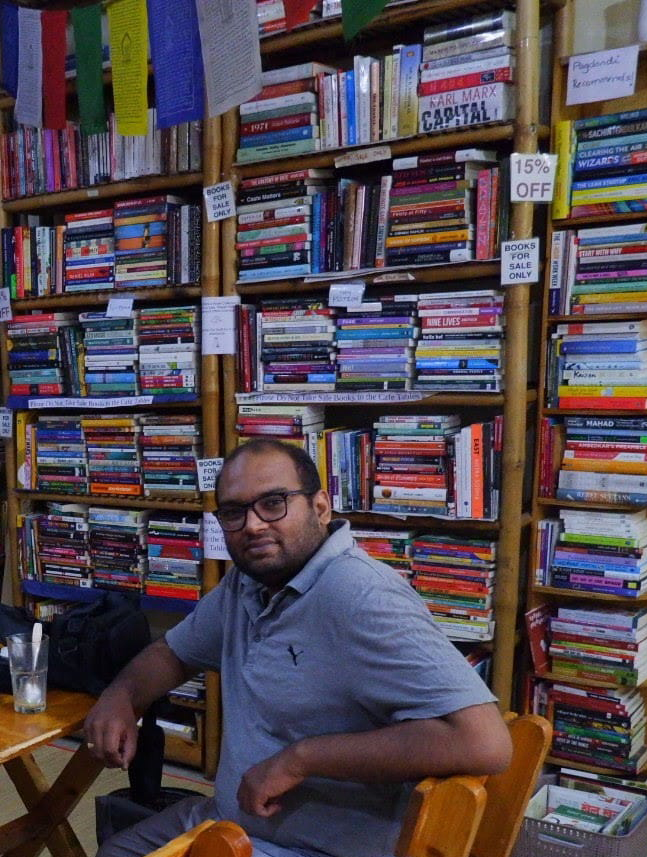
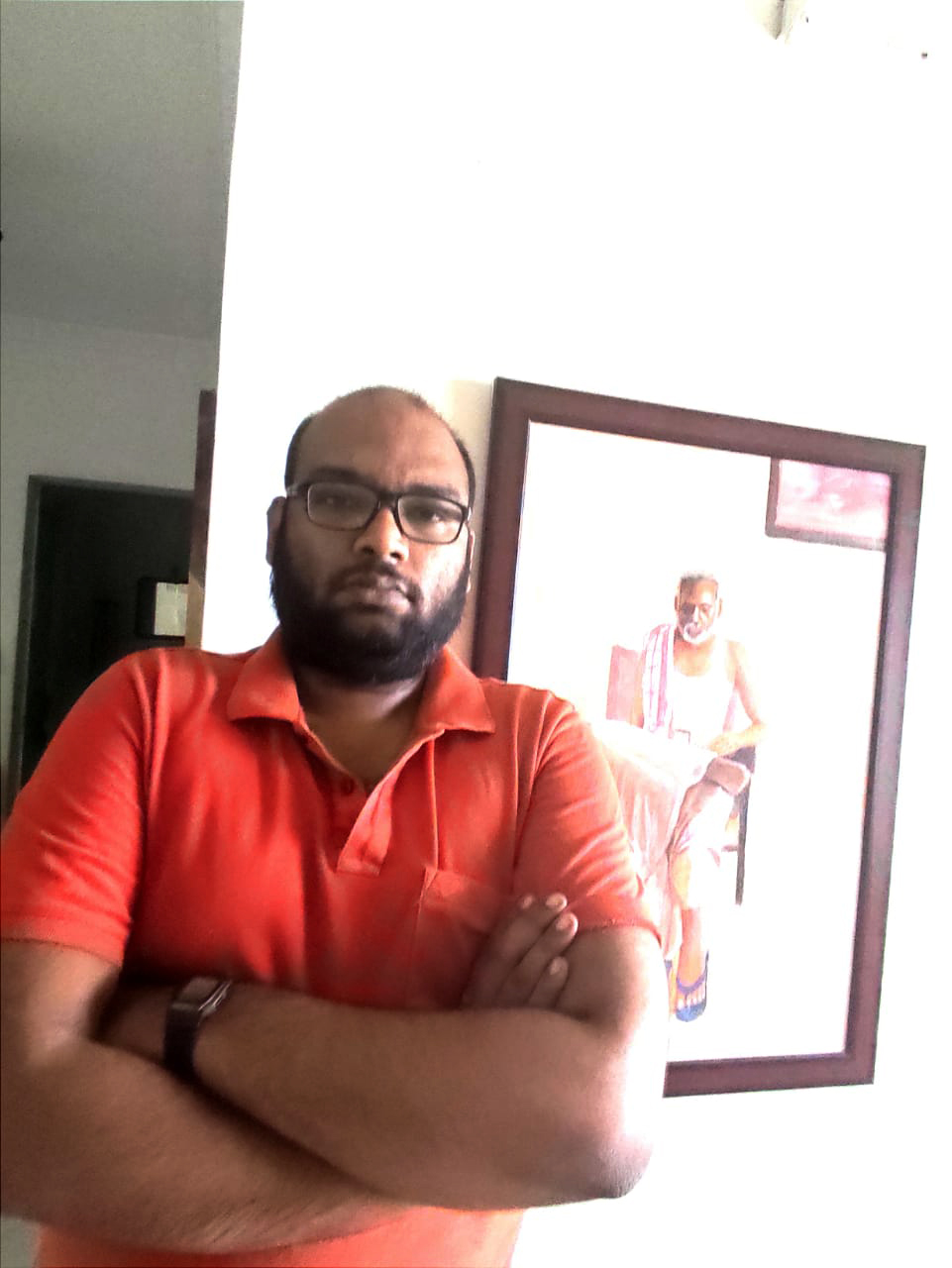
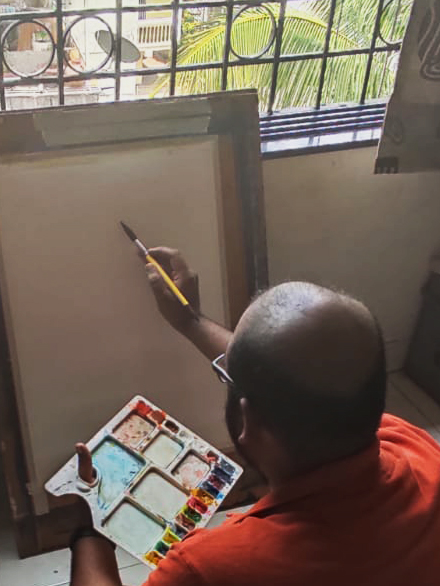
‘I can’t take instructions!’ Says Rohan Rathod.
We ask, ‘Why? What’s wrong with it?’
‘I do things differently.’ Rohan sounds blunt.
Rohan loved painting since childhood. But he was puzzled why other kids did not paint the whole house. Why did they paint it in such a way as if the house began and ended on the piece of paper itself! No third dimension at all! Soon he learned that he saw things differently.
He kept painting passionately until tenth grade. Then he appeared for the intermediate exam of art.
‘I received an extremely poor grade.’ Says Rohan.
We try to clarify. ‘You did badly in the exam. Right?’
‘Not at all. I was awarded a poor grade.’ He corrected our perception. ‘Of course, I did not even apply for admission in the art school. I plunged into a dark pool of suspicion that my confidence in painting was probably unfounded. Perhaps I was not good at it. But over the years, I realized that I just did things differently. In fact, now I know that I did well in the exam.’
He tried science. But the precise directive and defined ways of science did not gel with his spirit either. One day, he had a confrontation with the law of the land. He had to bear the burnt of being himself.
‘I decided to take up law as my subject and become a Lawyer.’ Says Rohan.
‘But then you hated rules, right?’ We ask.
‘Yes, of course. I took up law as my subject because I needed to know where the boundary is. I wanted to know beyond how many steps, freedom lives, and instructions render invalid.’
‘You are an outlaw.’ We observe.
Rohan bursts into laughter, ‘On the contrary I take a very serious view of the law. Law and order are for the routine stuff. Today the field of art is mystified such that it appears to be lawless. Finding the laws of art is my priority.'
Rohan’s portraits or depictions of household are not conventional. Sometimes, the sky is brown, and the face is painted in red. A fauvist shadow hangs faintly over his hues at times. And the next one appears to be a shocking juxtaposition of one familiar object with the other, bit like the cubists but not really. The women do not look beautiful in conventional sense of human form, but they never leave your mind once you lay your eyes on them. The rectangular space of Rohan sucks the viewer right into the depth of it with clues missing.
When asked why he painted strange images, he says, ‘I want to convey my feelings. It is my language. I know, viewers often find them enigmatic and fail to grasp the voice emerging out of it. I do not blame the viewers because I am trying to decode it myself.’
‘Don’t you think that commercial success may not be round the corner for such artworks? People want to see what they have seen before. It is painful for the neurones to wake up to something alien.’ We ask.
Rohan smiles. ‘My art is not yet adulterated by commercial factors. Just like the nature gifted me a different kind of vision, it also bestowed me with enough means to keep the kitchen running. I earn my living from my profession as a lawyer. But above all, as Susan Sontag said, art is seduction, not rape. My paintings are sending their voices out. The viewers are listening. It is not a scream. It is a tune. One day, the tune will enthral them. I have no hurry. Let me lay down all that I see differently. Let me show the world what I see.’
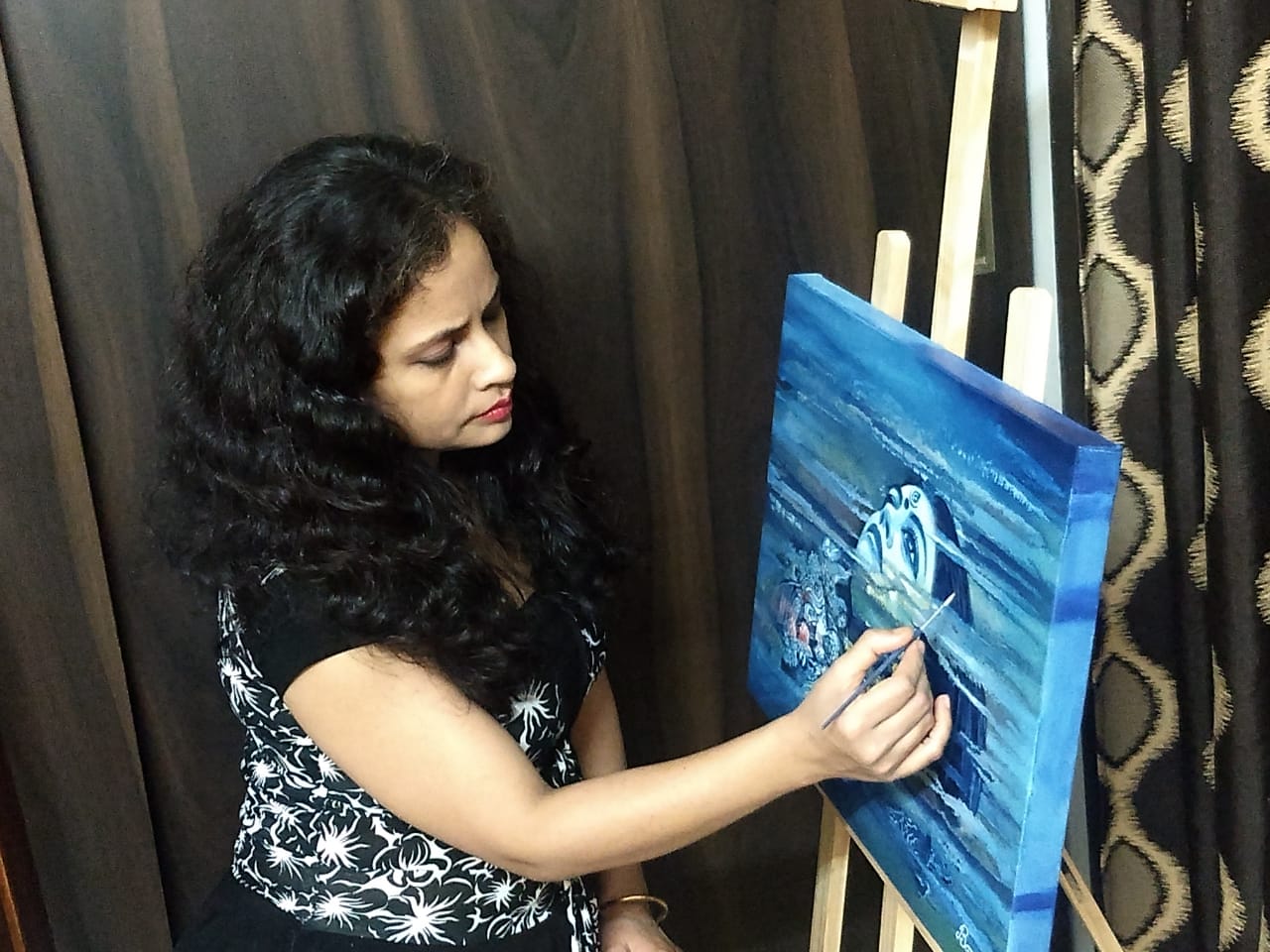
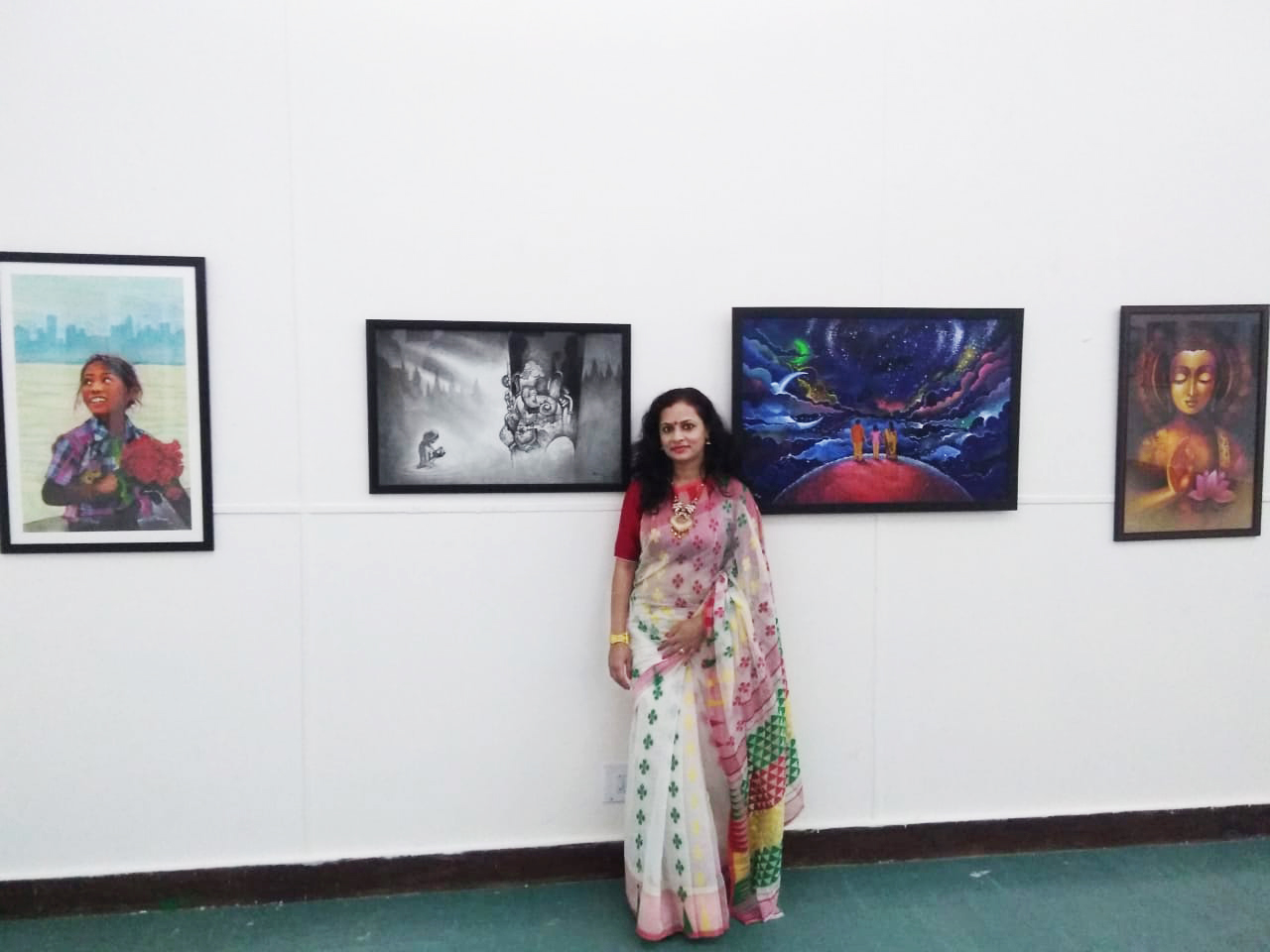
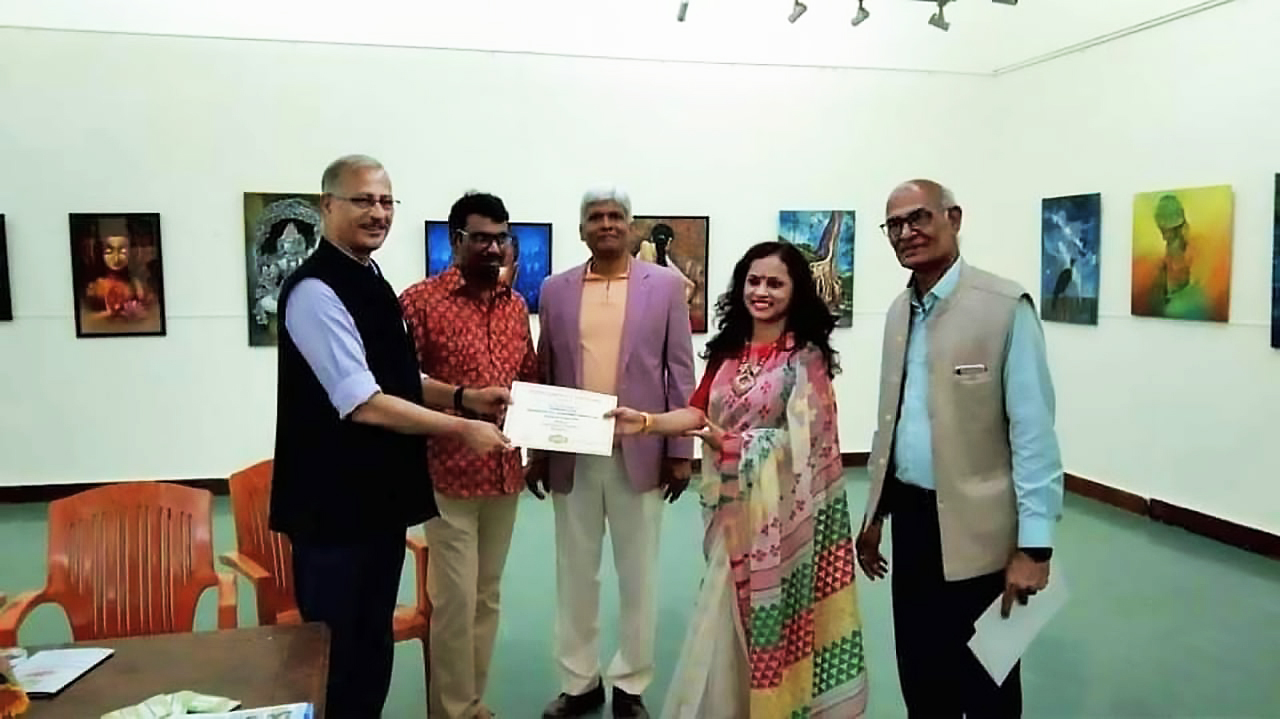
‘The carpenters made good progress today!’ He inspected the edges of the joints. The polish. The hinges.
‘Yes. I was seating before them all day.’ said She.
He was looking inside each of the shelves for any defect. ‘A task master, eh!’ He said laughing. Suddenly his eyes were stuck onto something left casually inside one of the shelves. He pulled that out and placed on the table.
‘They left something behind.’ He observed.
A rough-pad and a drawing book for children.
She hurriedly picked them up from the table, ‘No! The rough pad is mine. And the drawing book was there in the house since long.’
‘Let me see…what secret you record there…’ He teased and snatched the rough pad from her. He began to flip through the pages. Surprised, he raised his eyes, ‘You did all this?’
She nodded, giggling. ‘Yes. I was copying the images from the drawing book onto the rough pad. They are good?’
He looked at them one by one and compared with the images in the drawing book. At an image, he paused, ‘But it is a beggar in the drawing book!’
She smiled but said nothing.
He was puzzled. ‘You painted a queen, not a beggar!’
She spoke, ‘I saw a queen in the beggar. Is that unfair?’
He shook his head. ‘No! Of course not. It is beautiful! Do you want to paint?’
She considered the idea. Marital journey of the erstwhile young lovers was without imperfection. Handsome and beautiful, comfortable household, absence of conflict, financial affluence. Why not add a little more spirit to it? She nodded, ‘Yes!’
That’s how Banani entered the mysterious alley of art. It was late. She had to catch up quick. She needed a guru to guide her. But her hunt for the Guru turned daunting. Without the resolve to muster the craft of painting, she would have dropped the mission even before she found the guide. Finally, the celebrated artist, Sudhir Meher, took her under his tutelage. And there was no looking back. The passion for painting took the better of her spirit.
Once, during the early days of learning, her Guru asked her to bring a jug and place it on the table. She did. ‘Paint it.’ Said the master.
She grappled a bit with the still life in the beginning.
But after a couple of days, her husband was alarmed.
‘What on earth are you doing? Nine jugs in three days! You fell in love with this damned Jug! Am I not good enough?’ He said teasing her.
She argued, ‘Look at each of my paintings. Each one is unique. Not the same jug again and again. You see, as the morning marches into noon, the jug changes. Same thing happens when the sun goes down and night looms large! We do not need to buy new things in life. Changing colour of light does it all for us. New things are born every now and then.’
One day, her guru told her, ‘It is time. Show your paintings to the world. Take part in exhibitions.’
She did hesitantly. And to her surprise, she won the Master’s award among two hundred exhibiting artists. That was the beginning. She knew art was her way. Since then, her dedication to the cause of art intensified further. In a span of just few years, she won multiple awards and drew attention of the connoisseurs.
When asked, if she had enough paints and canvas to sustain painting during the lockdown due to Covid pandemic, she said, ‘Does not matter much. The goal is painting, not the medium. If I run out of oil, I shall switch to acrylic. If acrylic is over, I shall go for water colour. If canvas is missing, I shall have paper. I am going to paint at any rate.’
The world will be in for surprise. Her paintings will continue to be showstoppers sending the viewers into tailspin of thought time and again!
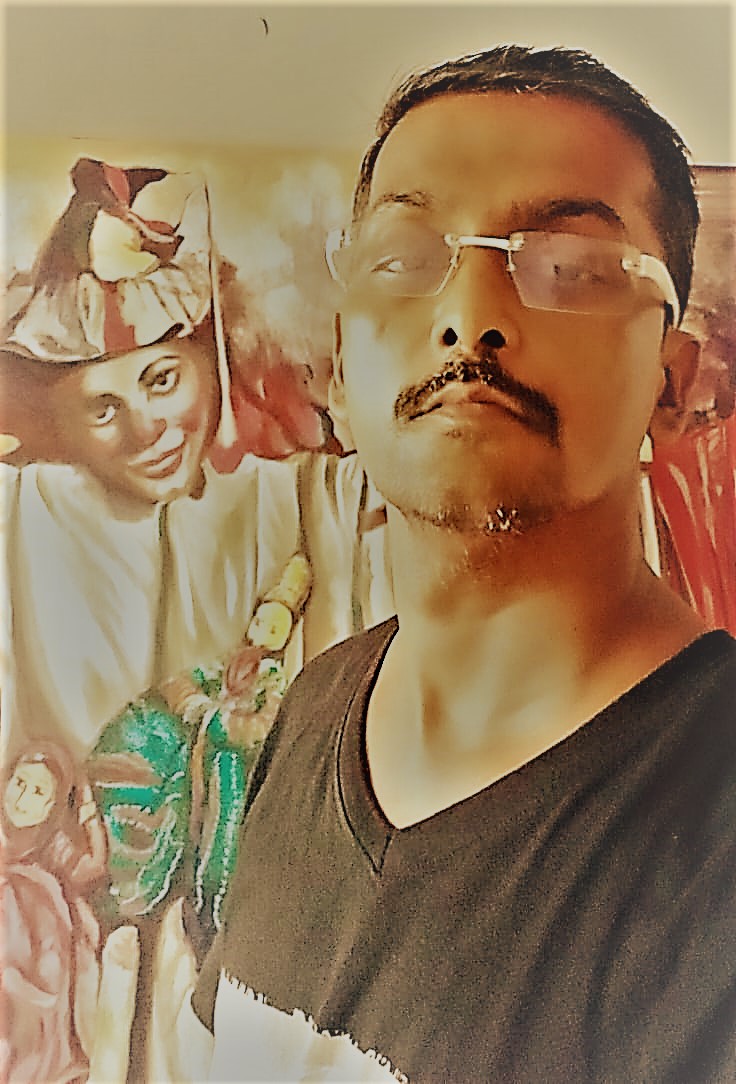
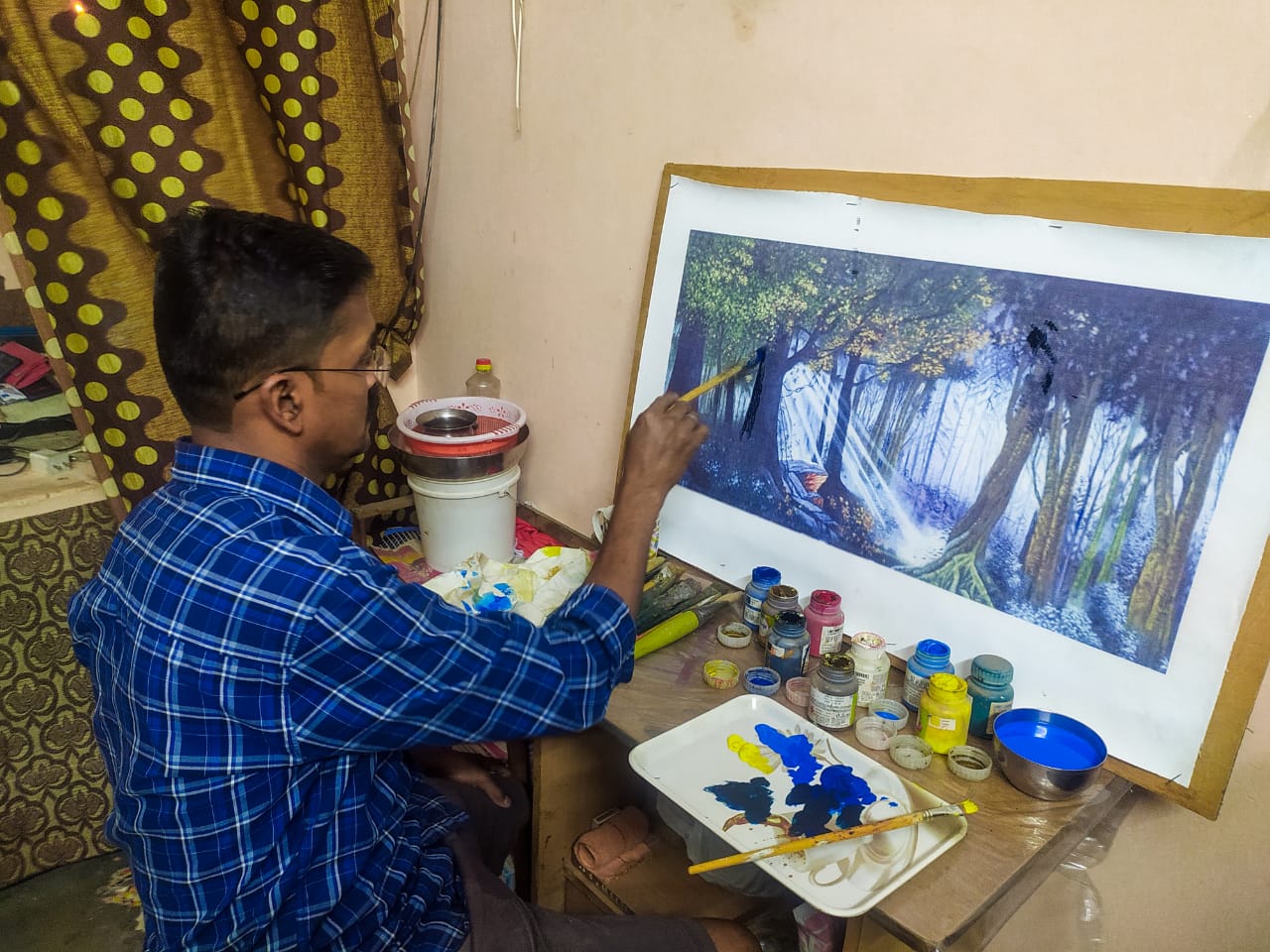
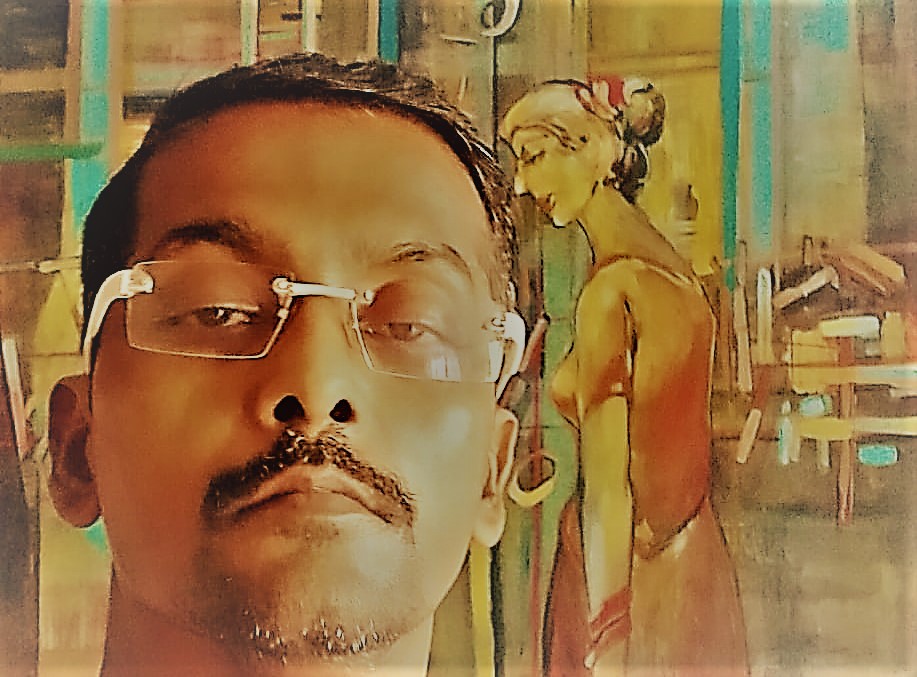
‘Shoe brush, shrubs, floor scrubber, rags, cotton and much more.’ Says Debashis.
‘What? Come again!’
‘Yes. You heard it right. I use all that for painting.’ He affirms.
Well, such strange tools are needed when the canvas is 100 feet wide and 50 feet high! But where on earth such canvas is displayed anyway? Academy award winning Hollywood movie, Alice in wonderland, used his painting as a backdrop! The spine-tingling action adventure, The mummy, used his painting as the background. These are just few examples. Whenever you watch a Hollywood blockbuster, you may be looking at a painting by Debashis in the background!
He and his team tackle fireproof special canvases of gigantic scale. Later, the completed canvas is air-lifted to be used in various parts of the world.
We wanted to ask him about the mysterious aura of some magical land in most of his paintings. But we did not. The reason was evident. The perfection and glaze as well as a chiaroscuro-like contrast seem to cut through the senses of the viewer. It is obvious that such vibe is demanded from the paintings for the movie sets of Hollywood. The same style reflects on the paintings he does for himself after getting back home late in the evening.
Debashis did not go to art college. He did not have a guide who taught him how to paint. He does not bother to discuss many details about his journey during the early days. He says, ‘I was in the middle of the exam of standard twelfth when this advertisement appeared in the newspaper. They wanted to hire artists. After one of the exams, I rushed for the interview. After the discussion and a test, they asked if I could pack my bags and board the train for Delhi the very next day. I asked for a few more days because a couple of exams were still pending.’
Back at home, he announced his decision. His parents were shocked!
‘This is ridiculous. No way! You are not going to Delhi for the sake of painting, of all things!’ In a few days, he was on his way to the station. And there was no looking back anymore.
With plenty of awards and exhibitions on international platforms, he has already established himself as an artist of repute. He has also been granted an honorary doctorate.
When asked if he liked to paint all day, even after going back home, he says, ‘That’s what I love to do. Moreover, there is a lot more to paint. I must hurry!’
His bursting passion and energy tell us that Debashis is set to go a very long way to leave his mark in the history of Indian art one day. There is surprise in store from the artist of resolve.
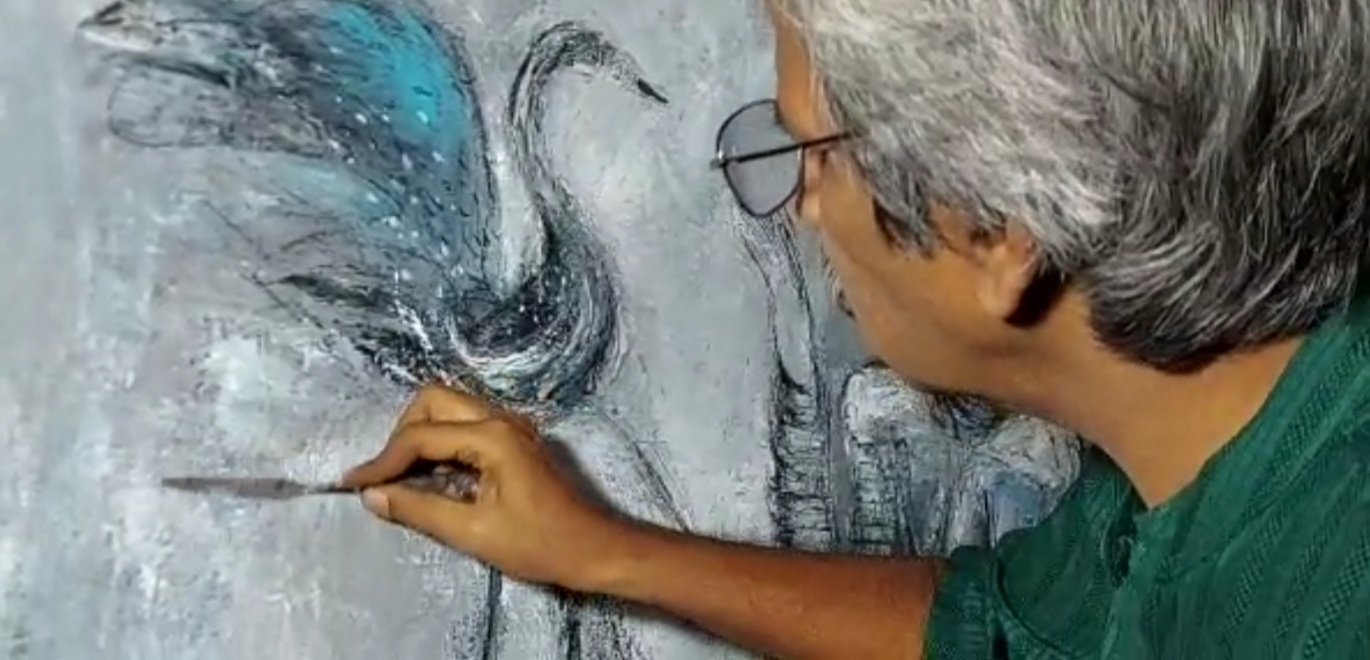
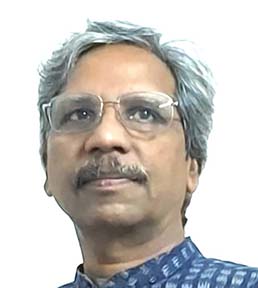

JOEL'S JOURNEY INTO THE WORLD OF ART
by Meera Srikant
Joel Gill, an expressionist artist, has been associated with art all his life. But it is only in the last few years he has found his language of expression and is gaining recognition quickly for the depth and vividity of his subjects.
A 13-year-old boy, playing truant from school, peeped into a room filled with paintings. A kindly lady, seeing the boy, beckoned him and provided him with papers and colours. “Would you like to draw?” she asked. The boy nodded and eagerly sat down, lost in the world of colours and imagination. There was no looking back after this for this boy. Fate had brought him to his destiny, National Bal Bhavan in Delhi, with which he would be associated for several decades in various capacities.
When he was just 8 years old, one of his schoolteachers, impressed with his talent in drawing, had recommended that he be sent for a competition. Though he lived not far from the venue in Old Delhi, his family had neither heard of this place, nor did they take art seriously. The boy was good at studies and they wanted him to pursue education seriously so that he could make a future for himself.
Joel Gill did study well, but he was able to pursue art in parallel thanks to the kindly lady, Saavitri Shrivastava, at Bal Bhavan. He was there every day, learning and trying out different styles. Impressed with his skills, he was asked to join Bal Bhavan as a teacher and soon, through the institution, he also started doing illustrations for publications.
One of his friends introduced him to the world of comics and soon, Gill also started doing comic illustrations. “What people liked about my work was my thought process. People came back to me repeatedly because I was able to understand their needs and deliver what they wanted on time,” he explains. This diligence enabled him to learn the nuances of publishing too and soon, he was heading the publishing division at Bal Bhavan.
Yes, life seemed good. He was also winning prizes in art competitions and displayed his works at exhibitions. But strangely, his fellow artists did not take him seriously. He may have been good at illustrations and great at drawings, but he was not an ‘artist’.
This made Gill pause and wonder what he was missing. He was drawing, but he was drawing what others wanted of him. Where was he, his individuality, his creativity in all this?
As a commercial artist, he had a nest egg, a roof over his head, a family and a comfortable life. But slowly, he felt a craving for art. He had attended courses over the years to upskill himself in the various forms of art. He took retirement a few years ago and now, he spends time in his studio giving expression to his thoughts and feelings. He is greatly affected by current events and his works capture the impact they have on people. For instance, one of his recent paintings ‘I Can’t Breathe’ was inspired by the unfair killing of George Floyd, a black in America.
Influenced by artists such as MF Hussain, Gill’s paintings belong to Expressionism genre. Though he has always been involved with art, he feels he has finally arrived home. In this journey, he is grateful to the renowned artist and art critic Ashok Bhowmick for his guidance. He aspires to go deeper and deeper into the art so that he can express himself better and better, using his brush strokes to narrate universal stories of human life and living.
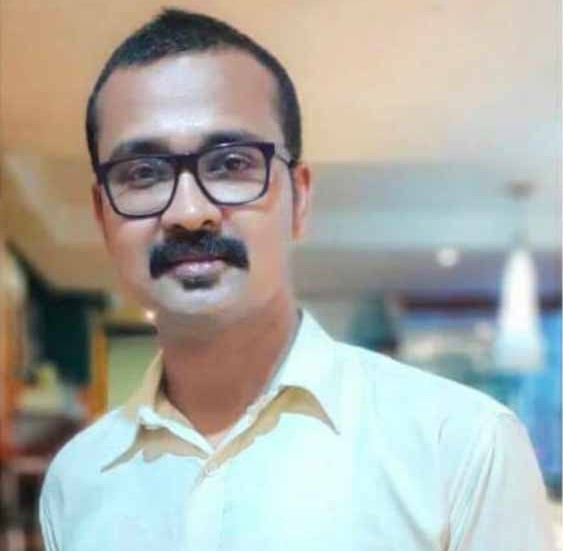
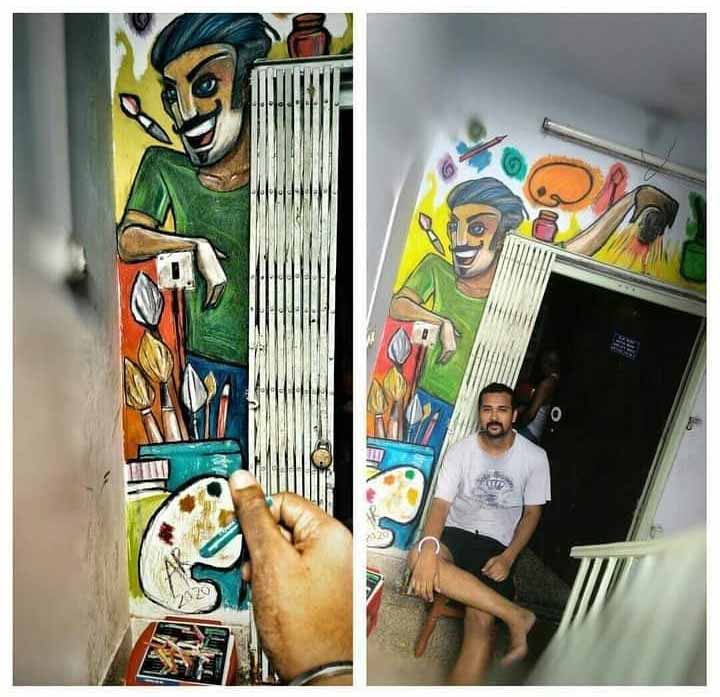
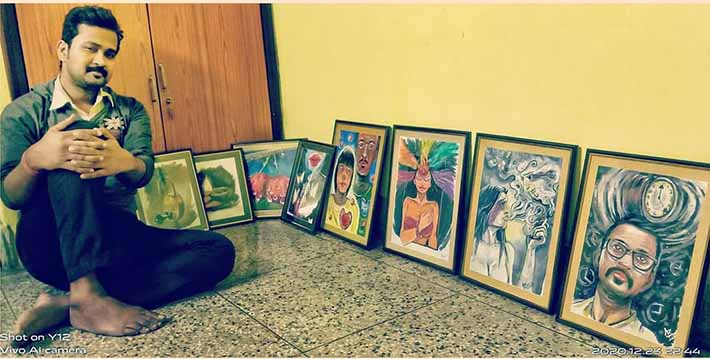
Colour of silence
by Saikat Baksi
‘What are you doing? Show me!’ The colleague in the cafe snatched the piece of paper from him. He did not answer. To be precise, he could not answer. He could not hear what was said. He was deaf.
A gentleman entered and ordered a cup of coffee. His colleague carefully kept the paper aside and busied himself in a hurry with the coffee machine. Quickly he served the coffee and went back to the piece of paper. Looking at it in amazement, the colleague said in sign language, ‘You can sketch like a master! What are you doing here?’
This is the story of artist Arijit Roy.
Since childhood, he and his parents wanted to see him as an artist. They made him appear for countless contests and he won top ranks in most of them. He was awarded first prize in National art competition in Delhi.
But life had another plan. Even after getting admission into Birla Academy of arts in Kolkata, Arijit had to quit after a year due to commercial challenges at home. He was young, handsome, charming. Only he could not speak or hear. Soon, the nation-wide coffee chain, Café Coffee Day, appointed him.
Art got confined within the scrawls on white pieces of rough paper during occasional breaks in the cafes. The rest of his time went into serving the hospitality sector. As a rising star in the Café Coffee Day chain, he received enough recognition but deep in his mind he knew that his true calling was not being answered.
In the meantime, one day, he came across Arpita at the sales counter of KFC. In a blink they knew that they must walk hand in hand. Love does not require noise. Love thrives in silence. They fell in love and married soon.
Arijit cherished the warmth of a loving and vibrant family. A family that knew that the true calling of their loved one was art, but the survival instinct made noise. Arijit could not dedicate himself to the canvas and paint in totality.
And it was then that the corona virus entered the lives of 1.3 billion Indians. Offices and cafes shut their doors. Roads turned deserted. Arijit too was trapped within the four walls but suddenly, he got his twelve hours a day back!
He resumed painting in manic frenzy. No more looking back. Decades of trapped passion poured out in a desperate gusto on canvas. He rolled out one painting after the other in rapid succession. Riots of colour flew like sparks. Soon he began to get recognition in online platforms which came in vogue due to the disappearance of the offline world. Awards flooded in.
When asked if deafness is a handicap for being an artist, he replied, ‘No, it is not. It is an advantage. The distracting noise of the world does not reach me. I can work in peace. My focus does not stray into things of insignificance.’
He is the manager at French loaf these days and a bit worried about the consequences of lockdown affecting the hospitality sector. He wants life to return to normalcy again. But deep in his heart, he wonders about the twelve hours a day. He must carve out enough room for pursuing his art even if there will be a life in the café. He must. And he will. Many more sparks are yet to fly.
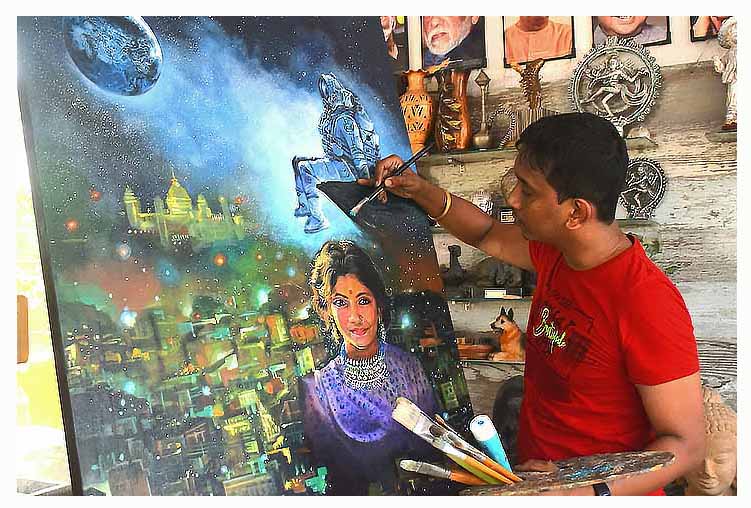
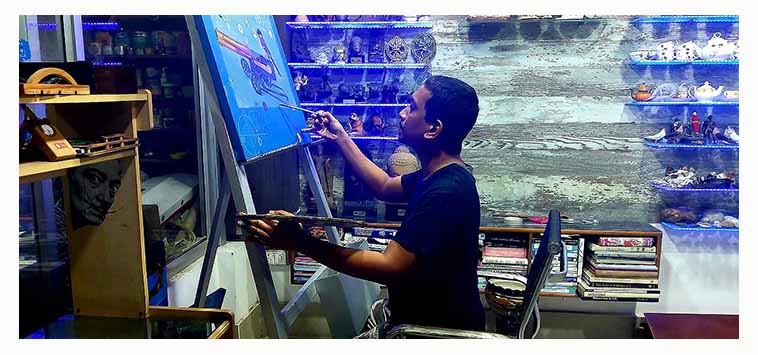
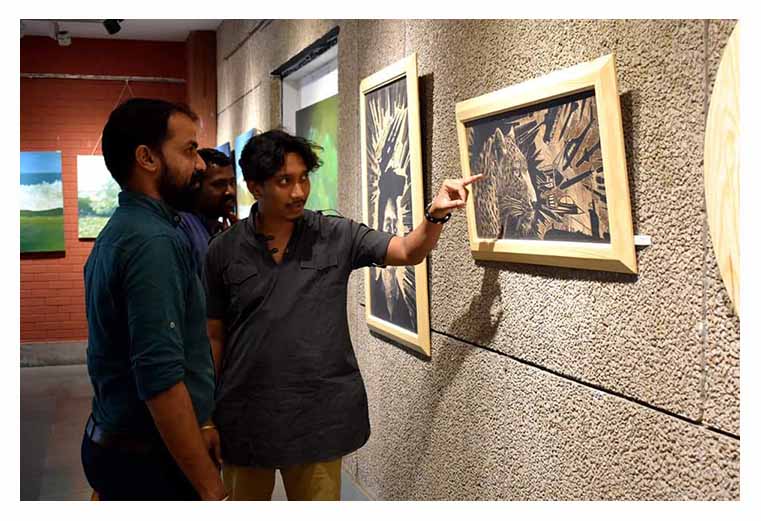
THE LAMP OF PASSION
By Dr Amit Biswas
‘What are you hiding among your books?’ His father wanted to inspect the entire content of the schoolbag. He was panicked hunting for an excuse to vanish from the spot in a blink.
His aunt came forward, ‘Oh! He had been taking notes. You saw that white notebook, right?’
His father nodded, still suspecting of some contraband like a love-note or something even worse, like a casual sketch of some tree or hut or some damned bird.
His aunt assured with a broad smile, ‘I bought him that notebook. His notes are scattered here and there.’
‘I see.’ Anxiety lifted off from his father’s face. Brows relaxed. He eyed his boy for a few moments and left.
Aunt led him to the door. He was to head for the school. At the doorway, his aunt whispered, ‘Did you sketch anything new?’
He looked at her with eyes twinkling in mischief. ‘Yes!’
Jyotirmay was not expected to study art. From a middleclass perspective, like any other parents, his parents too wanted him to take up a profession that promised a secured future. The idea of their loving and brilliant boy ending up at 1Kumartuli making clay idols of Durga and living in the ramshackle shanties, petrified them. No! Art had no prospect beyond that.
But their young boy could not overcome his true calling. Playing with mud, making figures of animals and people as well as machinery, was his game. He loved drawing too. Being a very bright student, he earned his freedom to engage in his pastime of sculpting as well as painting. As long as it was a leisurely fun, it was alright. But when he expressed his desire to go to art college after school, his parents did not buzz.
‘No way! You are going to take up Bengali honors for graduation. We can not gamble your career away! Painting may be a good hobby but not enough to earn a living.’
As it happens, destiny has its way. A man possessed by the passion of art can not be subdued by compulsions of life. Jyotirmay emerged from the graduate course with flying colors with a first-class degree but never gave up his dream of taking a formal training in art. He was preparing secretly to join Calcutta Art College. In the meantime, his art was gaining recognition from wherever he could reach them. His interest was growing in nature and eco system.
Once again, his aunt came to his rescue. And one more uncle. They convinced his father about the promising young artist. He took admission in Calcutta art college for his Masters. After all, several awards and accolades stood testimony to his worth.
As an artist with a fair experience of both, village as well as the life in a metro, his demeanor attracted appreciation rather than threats. With a die-hard positive attitude, he could distill the constructive essence of all criticisms. A national award in 2015 and recognition from around the world jacked up the motivation. He surged ahead.
Today, printmaking as well as painting are his forte. Surrealism is his way. Nature and ecosystem never fail to captivate him.
As an artist, he believes in order. He follows a routine. And, slightly out of convention, he is a teetotaler and does not indulge in smoking. He feels life is good enough already.
These days he teaches in Chitrakala Parishad, an Art college in Bangalore. The lifelong dedication of his parents to the noble service of teaching has not gone in vain. Their son is a lecturer too. He does not teach Bengali but teaches art. They are proud today.
Jyoti means glow. And the little lamp lit by the Uluberia couple three decades ago never refused to blink even under savage blows of wind. Drawing spirit from the storms of life, it evolved brighter by every passing day. Today it lightens up a thousand other lamps for future.
Jyotirmay turned into the Dalapati that he had always been!
1.Kumartuli happens to be the capital of idol making in Kolkata for all the Bengali pujas that one can think of, including of course Durga Puja festival.
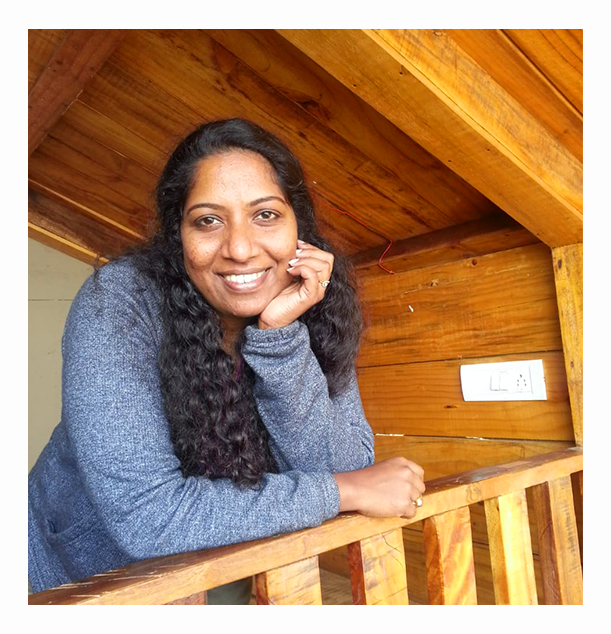
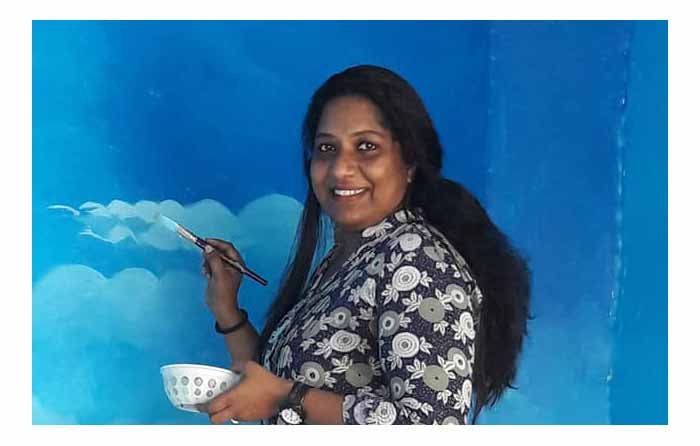
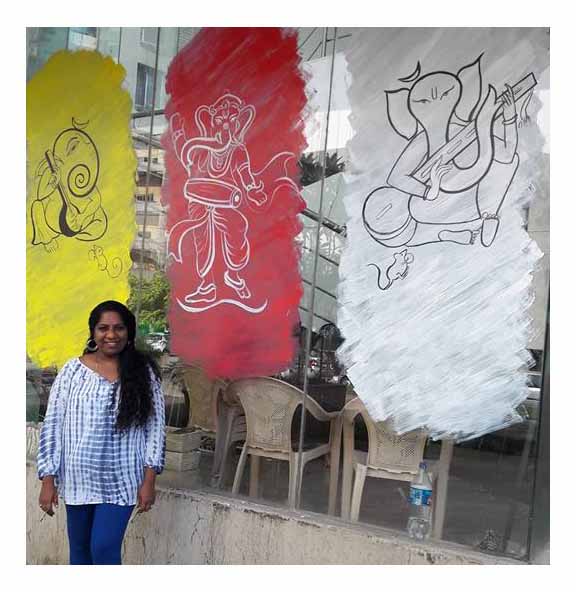
Honing a Jewel
by Meera Srikant
Sindhu Nair is all fired up as she pursues her passion for painting, a talent that had remained hidden in the pursuit of life but today colours every aspect of her life
To balance a family, a full-time career and a passion is not easy. But when there is fire in the belly, nothing is impossible.
As a child, Sindhu discovered her skill in drawing and painting when she copied a greeting card and later, calendars with beautiful landscapes. But in her academics-oriented family, soon it was all about studies and working towards a career. She was discouraged from pursuing arts, though her grandfather was an artist who ran a framing shop in Kerala. During vacations to her native place, she used to watch him at work. But there was just no time and she pursued engineering.
Her drawing skills helped not only her but her classmates too in her school days, but that was the extent of her artistic endeavors. Her father wanted her to pursue engineering, and Sindhu decided to take up mechanical engineering as it included a lot of drawings of machinery, if not landscapes. “At least the syllabus contained drawing, as compared to electrical engineering with limited drawing skill required,” Sindhu points out.
But soon after she was married and had her child, her friend Bindu started talking about her skill that she always admired and said, “Don’t let your talent go waste.”
After finishing her household chores and just before going to bed, Sindhu resumed painting. Watercolor was her medium but she realized she was good at sketching too. A workshop at work introduced her to an artist who did oil paintings. Sindhu went to the lady to learn to do oil paintings. But she realized that the artist was taking over her drawing and so she came away, taking her half-done painting with her. “I told her I will complete it at home and brought the painting away. I repainted the portions and learnt how to use oil paints through trial and error,” she reminisces. The painting – her first oil – got sold when she did an exhibition for the first time.
There has been no looking back since then. She has been experimenting with different mediums and styles and has a steady clientele. She believes in self-learning and has also started art classes for all ages. “Practice brings perfection. I tell to my students too,” she says.
The Thane Ayyappan temple wanted a painting of Lord Ananthapadmanabha and commissioned her to work on it. This is done in Kerala mural style, a very intricate and vibrant style, and replaces an earlier painting done by a senior artist. Every time Sindhu visited the temple, she had admired that work and longed for an opportunity to do something similar. On a visit, finding that wall empty, she asked the priest about the whereabouts of the painting. Apparently, there had been a flaw in that painting. But when the artist was approached to correct it, she took offense and took the painting away. He requested Sindhu to paint the Lord and it was like boon. She also found out she was pregnant at that time and the dimension of the painting 10x6 feet, not an easy task for a woman with a child growing in her womb. But undeterred, she completed it a month before delivering her child and now has the satisfaction of seeing her painting adorning the temple wall.
“Portraits are a personal challenge,” Sindhu says as she explains another one of her projects. Recently, she created a painting where she had to draw the faces of two fans of Daft Punk rock band as band members. Once she was provided a torn photograph of a ship and was asked to recreate it on a 2.5ft x 4ft canvas. When she sent it to the client, he thought she was simply sending back the photograph image by mail without realizing how realistically she had recreated it! When she sent an image to an online competition, they asked if she was participating in photography competition or painting. This encouraged her to work on realistic paintings and upgrade herself in that area.
Despite the steady flow of work, Sindhu does not believe she can shift to becoming a full-time artist, but her dream is to keep on painting. “What I believe is my work in L&T- Hydrocarbon Engineering is my bread and painting is the butter,” she says as she signs off.
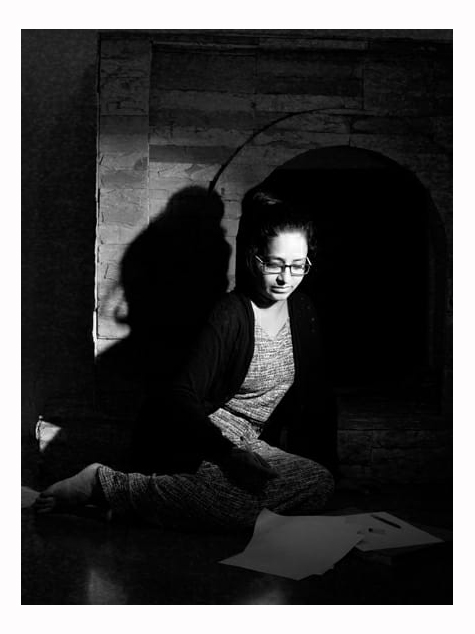
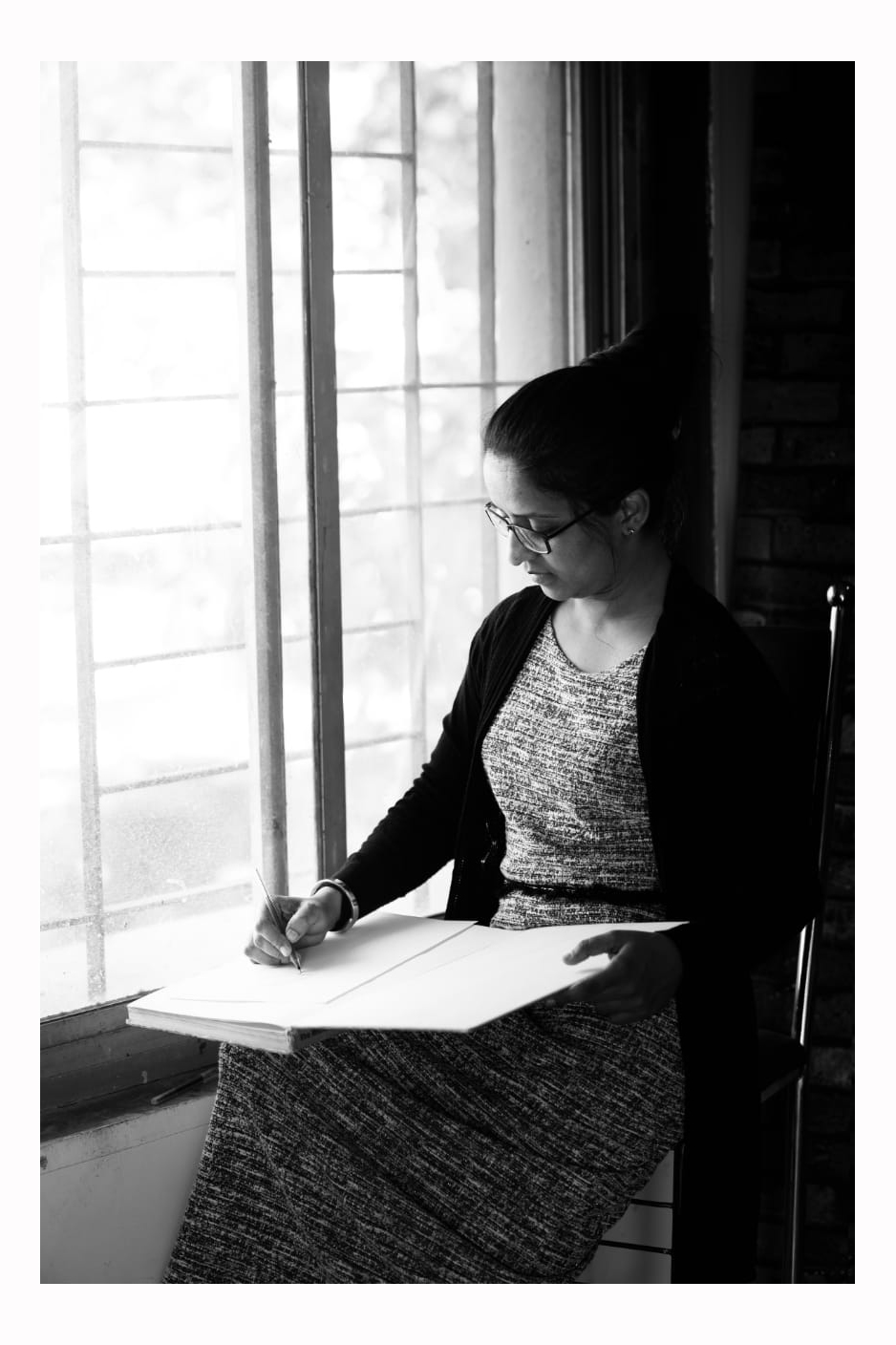
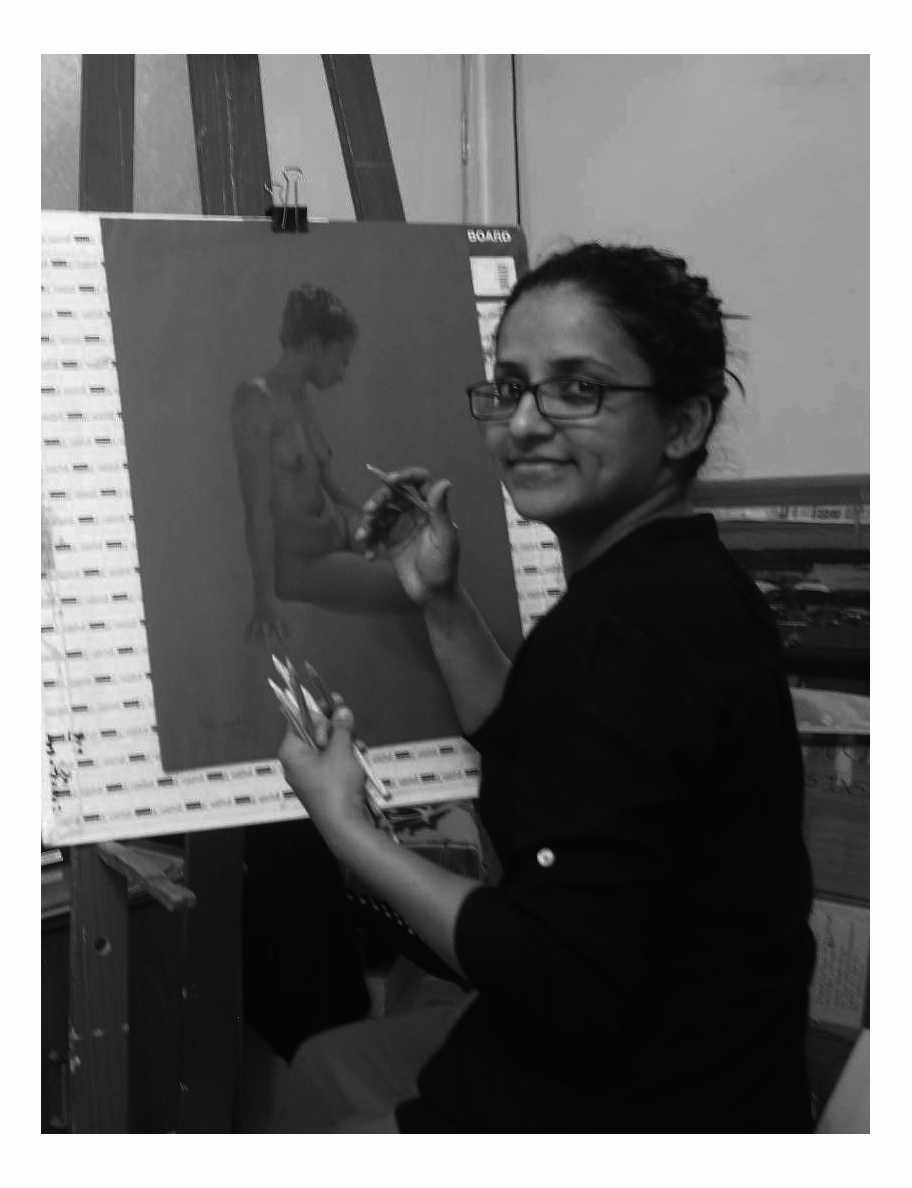
UNDEFEATED
By Saikat Baksi
‘How did the exam go?’ The young man asked his little daughter.
‘Oh! it was great fun!’ Replied the kid.
Her father was curious. ‘What do you mean by fun? Did you solve all the problems in the math question paper?’
The little girl laughed away, ‘I did some of them. But it was fun.’
‘Show me the question paper.’ Her father was getting an inkling about the meaning of fun.
‘Here it is. Look. This was a good paper. Lot of blank space. I painted five noses, two eyes and three ears. See, that blunt nose is that of the class teacher.’ She giggled.
Her father stared at the question paper wondering how to react. He did not know if he was to be happy or sad. His baby girl had a lot of fun because the maths question paper had plenty of blank space to do sketches! As usual!
He considered the options for a while and then said, ‘Okay. Well done! Let us go to my drawing classes. But when the elders are drawing, do not show them around their mistakes. Okay?’
His little girl grinned again in mischief and nodded her head vigorously.
That was Mansi and her dad.
Mansi’s father was an art teacher and a photographer. He saw the true spirit in his baby girl. His circle of friends and colleagues too did not miss the spark in her. After completion of exams of 12th standard, the family came to a crossroad. The convention of a middle-class Maharashtrian family demanded an early marriage and easy settlement in life. Ambitions were no safe territory. But Mansi loved exception. She wanted to study art. A compromise was reached. Art teacher diploma. Postponement of the ritual by two more years.
She went ahead but as soon as she completed the course, the marriage mission returned in full force. Mansi geared up for a tough resistance this time. A prolonged tussle with her elders. It began with fasting. But to her surprise, just after skipping one dinner, her father sat before her and asked, ‘So, what do you want? Study more art and marry later?’
She nodded. Her father smiled, ‘Granted!’
Mansi entered art college. Her passion was figurative painting. The eyes, noses and ears of the early years must add up to a complete human body throbbing in pulse of life. But soon, she realized that the figurative studies done by her were not really heading anywhere. Somehow, the head belonged to someone and legs belonged to another. But when she came across similar works by students at art colleges from Mumbai, she found that the harmony was striking.
Why?
She could not compromise on her skill. She must find the root cause.
And the revelation flashed one day when the old, withered marble statue of a nude human body was again presented to the students to do figurative study! Mansi realized right away that she needed a live model. The battered age-old sculpture was not enough. Colleges from Pune and Nashik, being conservative, did not permit any live nude models in the campus. But in Mumbai, nude study did not raise any eyebrows. After all, Leonardo or Michelangelo dissected dead bodies in the morgue in secrecy to understand what lay beneath the skin. That is how they could attain such extremity of realism. How could an artist of this day get by the lessons just by looking at a stone sculpture?
But then what was the way? Getting a model itself was difficult and expensive. The task of a model was very demanding. Seating or standing still for hours is no easy. Often models collapsed under extreme duress in the middle of the session. Besides, even if she managed to get one, what might be the venue?
She could not bring the man or woman to her home to pose for her. It would spell scandal. Neither could she take the model to a hotel for study. It could result in even worst consequences. But this challenge was not enough to dissuade Mansi from finding a model.
Convention never appealed her anyway. She knew that creativity lived out of the box, not inside. So, one fine day, she struck the golden idea. Eureka!
The idea solved the entire problem, but it came with its own dangers. And she knew the pitfalls very well. The warrior in Mansi resolved to fight the odds out. Protocols and conservatism were not enough to block her way.
SHE DECIDED TO BE HER OWN MODEL!
Since that day, she shuts the door of her room and seats before the mirror and paints herself on the canvas or paper.
Indeed, her nude figurative sketches appear mysteriously beautiful. Perhaps Mansi is exploring her own mystery through the scratches of charcoal. Her paintings attracted enough of critical acclaims. The art market too responded well to her figurative studies. Awards came plenty. Connoisseurs observe that in her paintings, nudity does not stand out, but the subject matter speaks volume.
But that is not all.
Breaking the convention has a price. People often say that Mansi Sagar is playing stunt. She is deliberately making her paintings sensational by projecting herself on the canvas. At times, she is accepted in exhibitions as an artist but is warned that she could display images only without nudity.
Mansi does not mind the rebuffs.
Her only concern is about her dad. He is proud of Mansi but worries a lot.
No. Not embarrassment.
‘How much hurdle will the girl overcome in life?’ worries her dad.
Mansi takes a deep breathe. ‘I have a long way to go…’
Note - To know more about Mansi's works, please visit http://www.mansisagar.com
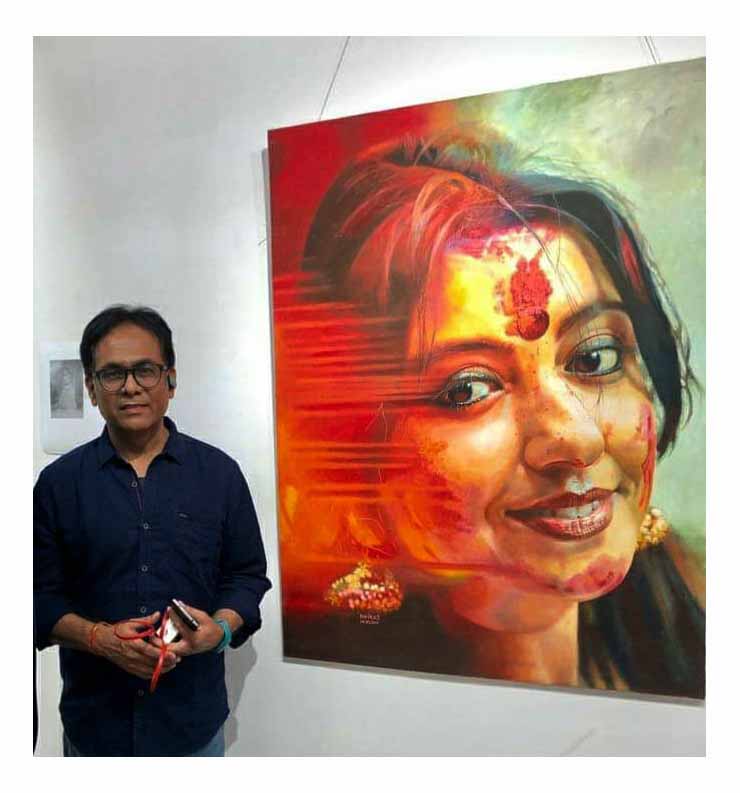
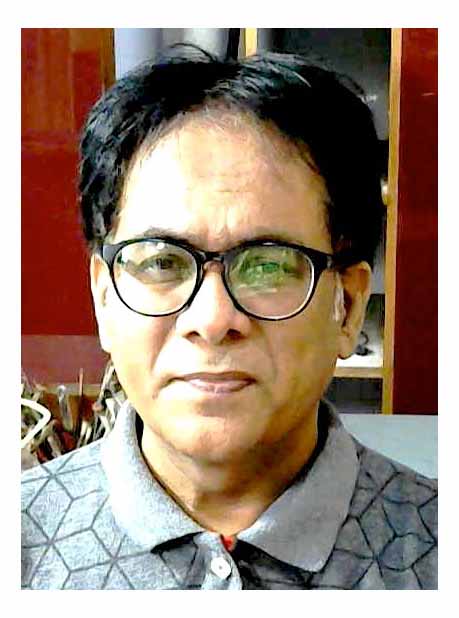
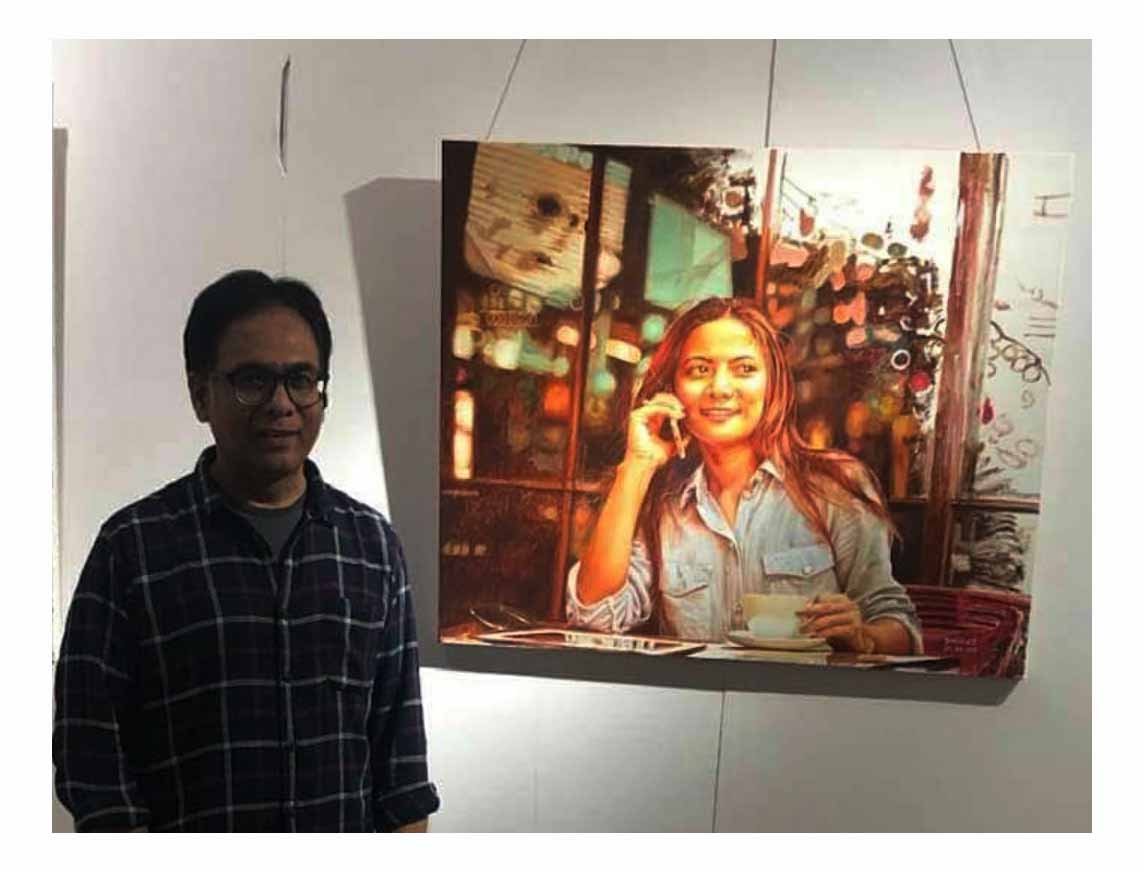
Reality redefined
by Poornima Kavlekar
“My parents and sister have told me that as a three-year-old, I used to sketch pictures from magazines,” recalls Dhiraj Khandelwal. What drove him to do it, still remains a mystery to him but this is his memory of how he started his journey.
As he grew older, he participated in many school art competitions and won prizes, but admits; “They were nothing out of this world.”
He completed his Diploma from International Institute of Fashion Technology, New Delhi. He wanted to join the Delhi College of Arts, but, he says, “they were not entertaining students from Rajasthan during that period.”
He did not turn to painting during his early days. He started working for an advertising agency in New Delhi and spent almost three and half years there. Eventually, he returned to Jaipur, got married and ventured into a different professional journey. He started designing and doing interiors of homes as well. “In 2006, I started taking turnkey projects in interiors and entered the construction business,” Dhiraj recalls. He constructed Bungalows and Apartments in Jaipur for almost 7 to 8 years.
However, life changed for him in August 2014. Again, nothing dramatic he says. “I simply did not want to waste my painting skills by doing interiors and construction activities.” He quickly adds, “It was a tough decision to move out of this business, giving up better monetary compensations.” He could not consider doing both the interior work and painting as it would have been exhausting, especially considering the deep involvement of the mind.
He turned to his canvas and colours full time. So far, he has worked on more than 250 canvases. He sends his work to World Art Dubai, Singapore exhibitions and Jawahar Kala Kendra, Jaipur, among other places. He is a realistic and semi realistic artist and his work ranges from use of light and shadow to create the illusion of light from a specific source shining on the figures and objects in the painting, to true photo realism using fine shading.
Right from a very young age, Dhiraj was fascinated by pictures – specifically faces of women. “Faces are like elixir to me. Told and untold stories are written over every face” says he.
During his school and college days, he has painted faces of sports personalities, especially cricketers like Sunil Gavaskar and Kapil Dev. He has also submitted several commissioned paintings of prominent personalities like Raj Kapoor, Meena Kumari, Shailender Singh to name a few. He has provided 13 portraits of senior officers of Kumaon Scouts.
Faces and postures communicate with him in certain way and has become his core area of work.” “While I mostly click the pictures of the faces I paint, I have also taken some from social media after seeking permission from the owner of the picture, “says Dhiraj.
“There is a lot of recognition,” says Dhiraj, “but art related prospects is not much in India as it is in the international level which leaves us artists struggling.” He adds, “People appreciate us and have lot of events but do not put artists in front of genuine buyers.”
This is an ongoing struggle but Dhiraj is a happy soul as he is doing what he is passionate about. He starts his day early, typically at 9 am which goes on till lunch break. He resumes at 3.30 and ends his day by 6.30 PM. He takes about a month to complete a painting, if it is a 3 feet by 4 feet canvas. “I do not paint late nights and I prefer natural light when I paint,” says Dhiraj.
“I am always in cloud nine,” says this cheerful artist. This is because he believes he is doing what he was born to do. “It simply completes me,” he says.
Unbound dedication of Dhiraj to art reminds us of Ralf Emerson’s saying, ‘Art is a jealous mistress.’ Indeed, art requires absolute submission. And Dhiraj’s canvas reflects the presence of the artist in totality in every square inch of it!
The world will look forward to more of reality redefined by this amazing artist.
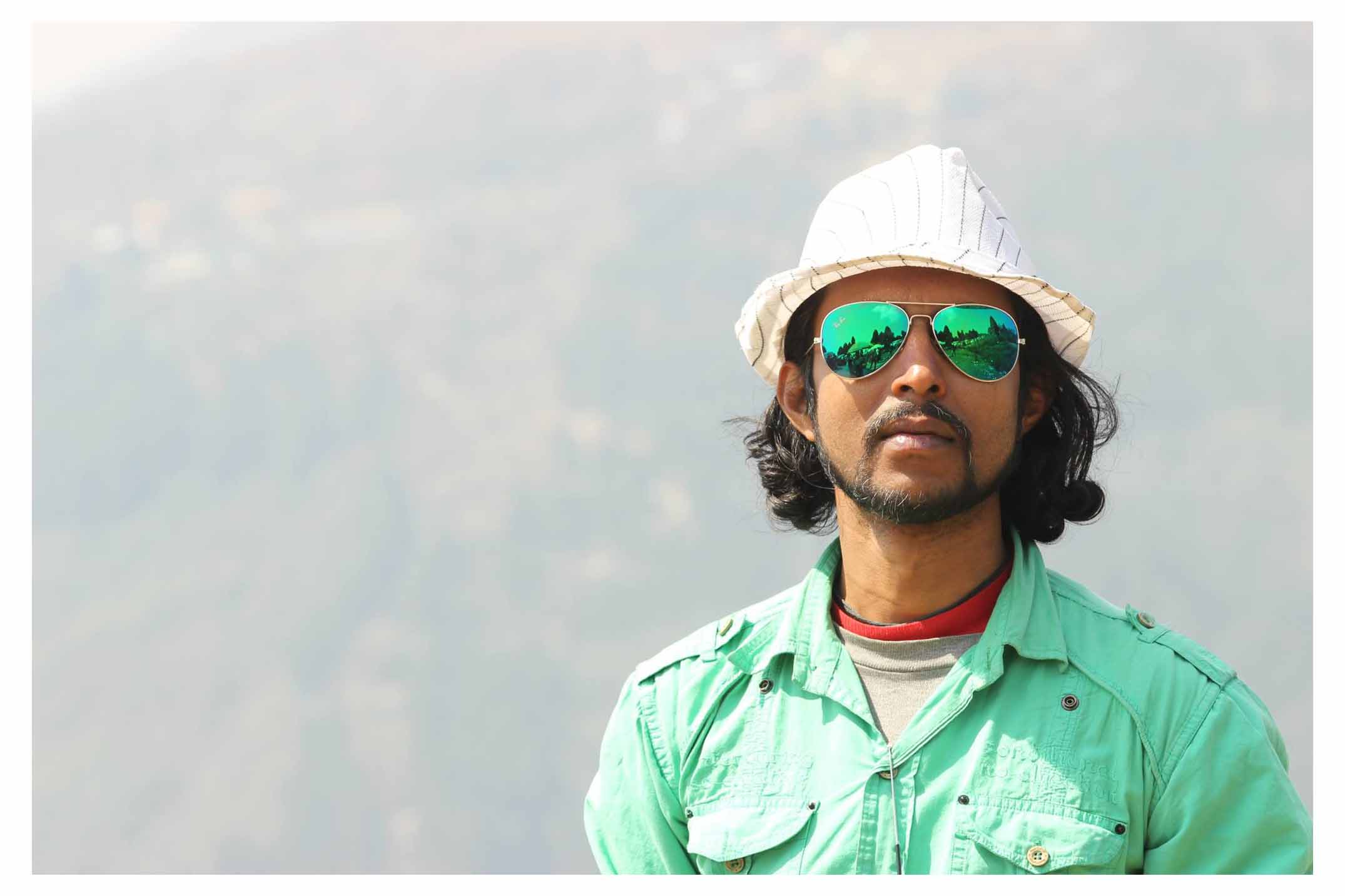
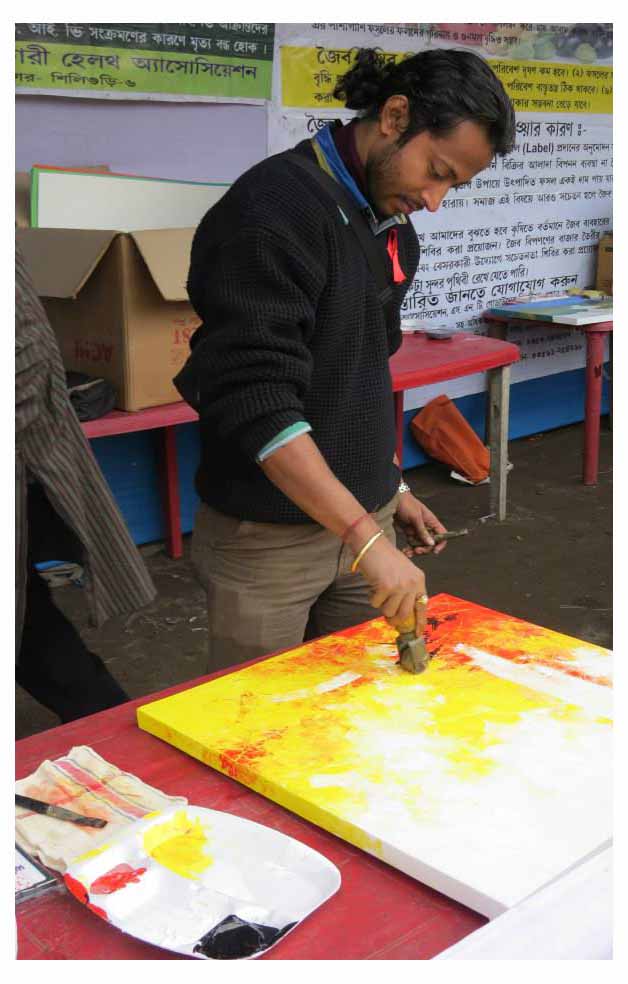
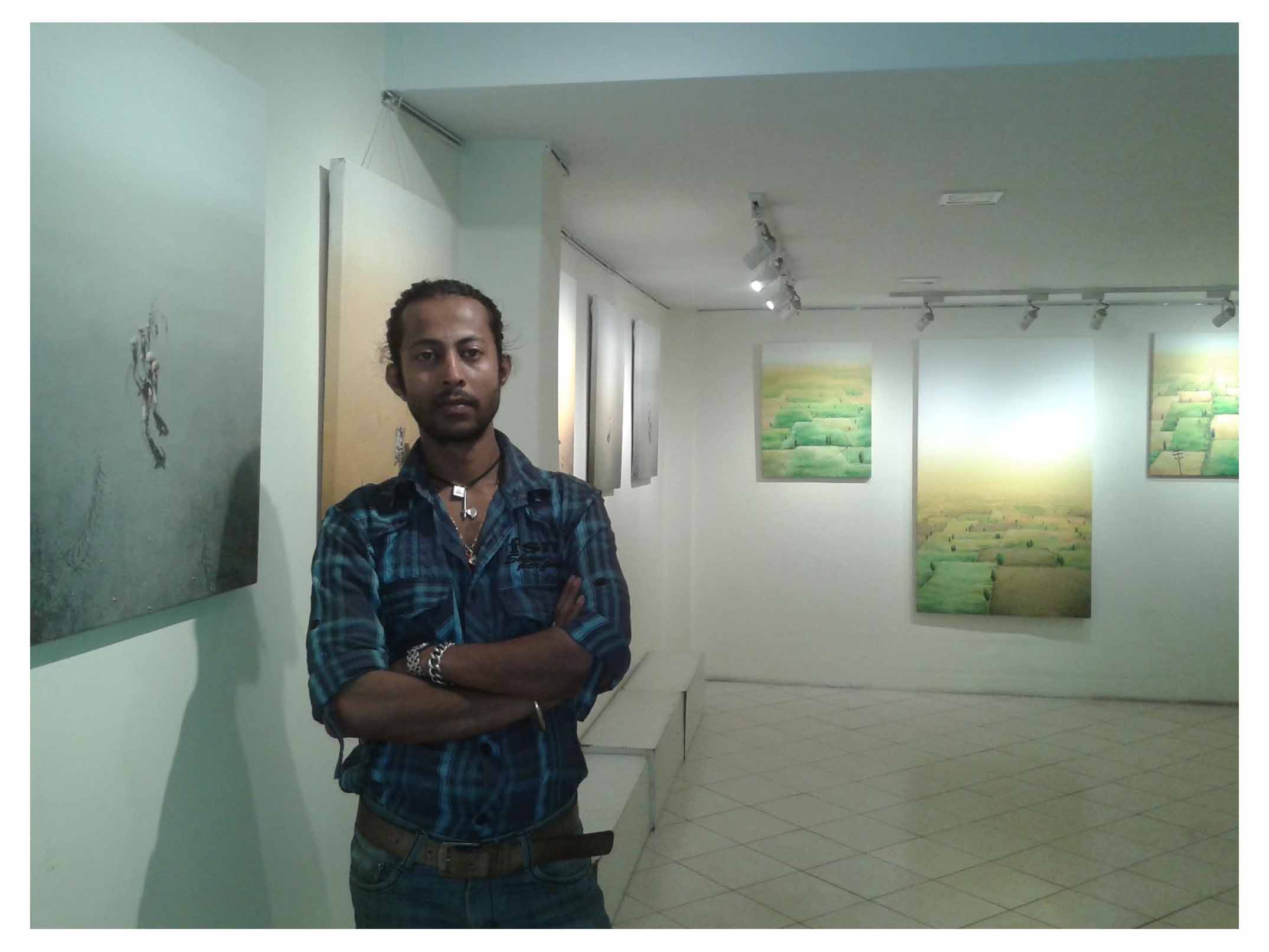
No Hurdle Big Enough
It was a spark that would not be put out!
By Meera Srikant
‘What kind of work do you do?’ Asked the prospective father-in-law.
‘I paint.’ Replied the young man.
‘That is great! But what you do for a living.’
Painting was not good enough! The question and answer, both failed to meet each other’s expectation. Nabin Das called off the suggestion of marriage. He would not have alliance with a family that did not have an eye for art.
Art enticed him early. As a child, he drew whatever caught his fancy. Throughout school and college days, he kept painting.
Growing up in Siliguri, West Bengal, he had no one to turn to for guidance. His father became unwell and Das was compelled to stay back and take care, doing B. Com from the local college. But all the while, he continued to paint, participate in exhibitions locally and even abroad. Appreciation poured in. He had to attend college only in the evenings, so that he could take care of his ailing father and also pursue his passion during the day.
“I learnt from the feedbacks,” says Das. He particularly recalls his exhibition in Chitrakala Parishath in Bengaluru and JJ Fine Arts College in Mumbai where the professors not only showered him with praise but also advised corrections. “In Mumbai, the professors sent the students to look at my work,” he says joyfully.
Nabin started with Realism but soon found himself drawn to Surrealism. Dali’s inspired him. He likes to tell a suspenseful story through his paintings. Such intrigue captures the viewers’ fancy. Buyers flock around his artworks. “I hear that the market for painting is bad, but my experience is otherwise,” he says with the innocence of youth. “Whenever I need, I find a buyer.”
Of course, he was expected to follow the family tradition of taking up some government job. When he did not buzz for that, the family offered to set up a garment shop for him. But Das remained stubborn. He would not part ways with art. There could not be a compromise. Just the way he refused to marry into the family that held art in low esteem.
His resolve made him the winner at the end. He is living off his paints and canvas and he is happily married today. His in-laws are proud of him. They stand by him.
In May 2019, Das exhibited 10 of his paintings in Taj Bengal. Not only did all of them get sold, but the three he had kept in reserve also got sold.
This made him bold enough to move to Delhi where he thinks opportunities are more. He moved lock, stock and barrel to the capital city, but since then, lockdown has put a break to his plans. Still, he is very upbeat about life and believes there is always a way. He will paint a lot many of canvases and achieve a great height. After all, he came a long way already fueled by just two resources – resolve and passion! He will go a long way driven by the same spirit.
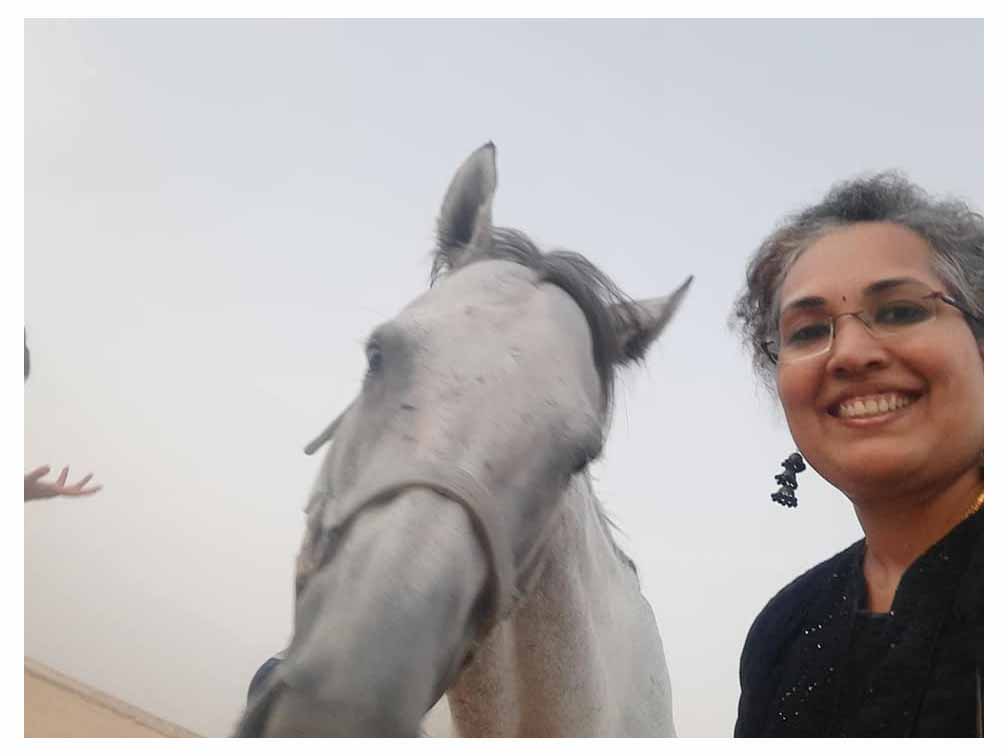
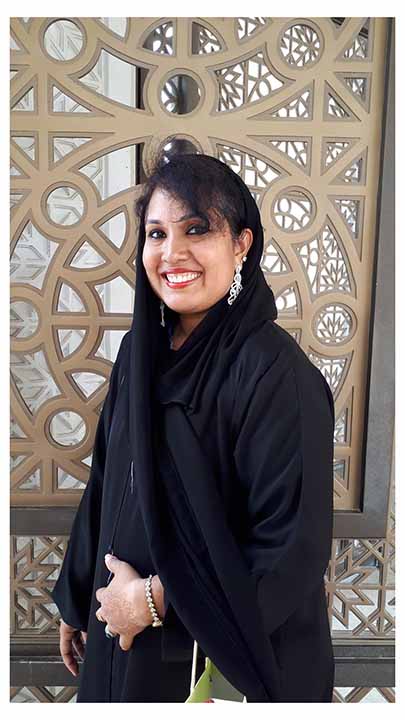
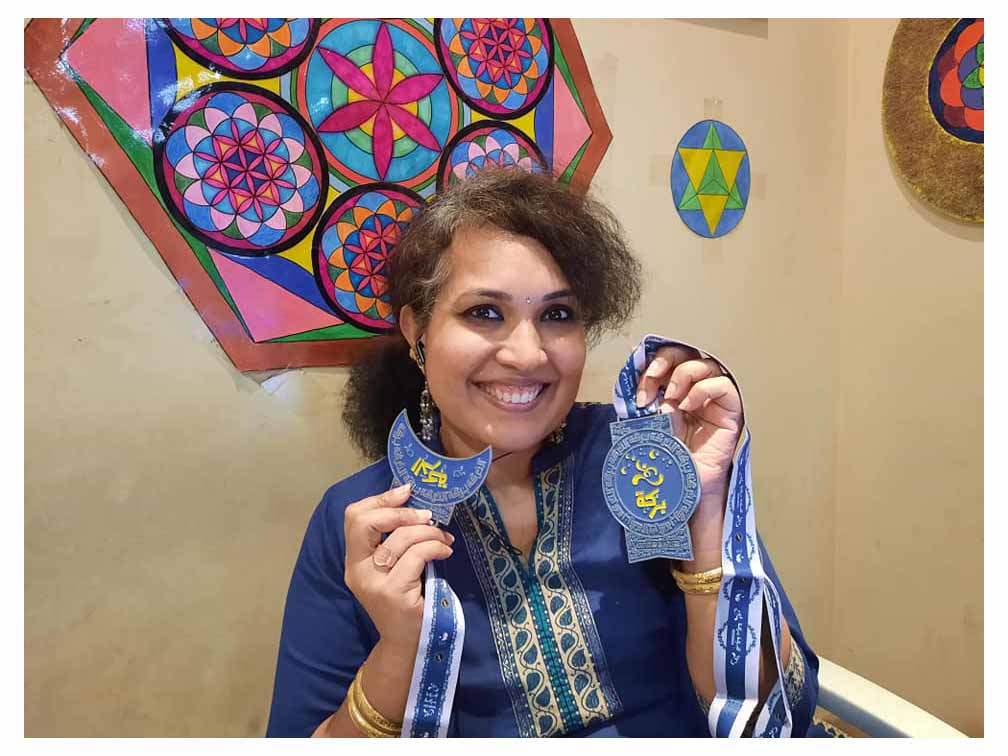
ART FOR ALL
By Dr Amit Biswas
“Art cannot remain the fancy for the elite. It must become a way of life for the masses,” believes Shreya. She doesn’t stop just with her beliefs. She works hard to ensure that her philosophy turns into reality, particularly with kids.
“Draw an X, then two sleeping lines, two standing lines and a circle, two more standing lines.” The kids follow her as she draws them on the board. Soon they are surprised to find themselves drawing. Shreya enthralls her audience.
Sitting right on the first bench in school, being the ‘good girl’ that she was, she would draw on the sticker labels, with her name on it. She would carry her dabba of color pencils wherever she went.
Later she learnt Tanjore painting. That was the only occasion when the family suppoerted her initiative in art, possibly because that traditional form of art carried a materialistic value too because of the gold foils going into it.
Through shifting from one city to another and marriage, she never lost touch with art, be it embroidery or helping other kids in school projects. But it was eight years back that she discovered YouTube to be a wonderful self-learning tool. There was no looking back. She also started teaching what she learned, to the young students.
She learnt zentangle, warli, madhubani, mandala, decopazh, coffee painting and several other art forms. Math being her first love, she began to blend art with mathematics. Fusion of the two became her passion. Through her Facebook page ABCD, Any Body Can Draw, she attracted thousands into drawing and painting. Shreya awards them for motivation, all free of cost.
The smiles on the faces of children with their discovery that they are able to draw and paint became her primary inspiration. Once during an online class for very young children she found a grandma saying, “mujhe bhi karna hai, hato na, ek notebook chahiye mujhe bhi…” These are what she considers her awards.
She believes in prevention of waste generation and positive recycling. She demonstrates young students how art can help recycle junk. At times, she lands up on the beaches of Doha, hand picking plastics and other waste discarded by tourists and cleans hundreds of square meters.
Even if she teaches both, art as well as mathematics to hundreds of students, yet she laments that she is respected as a math-teacher but not much as an art-teacher, “isn’t this unfair to art and artists?” She exclaims. Hence most of her art classes are free.
She concludes saying “My art may not make it big, but some of my students will surely do.”
Shreya lives for her philosophies, her entity as a teacher, her social work, her deep concern for the environment, and tying all of them up in her activities.
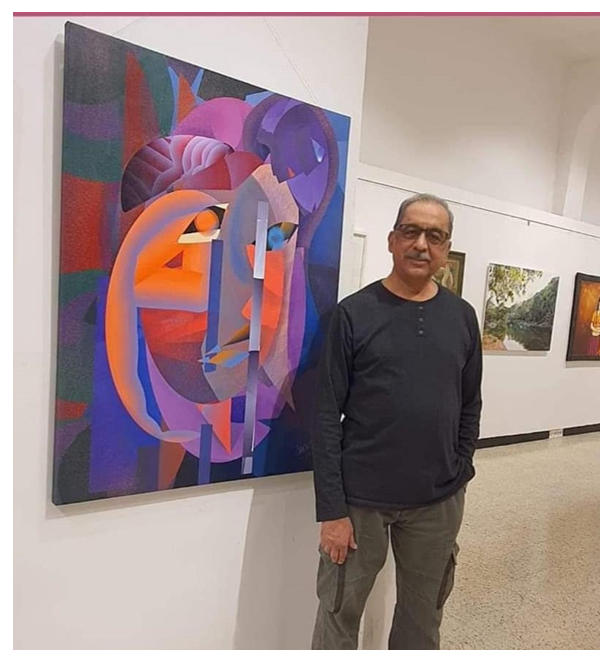
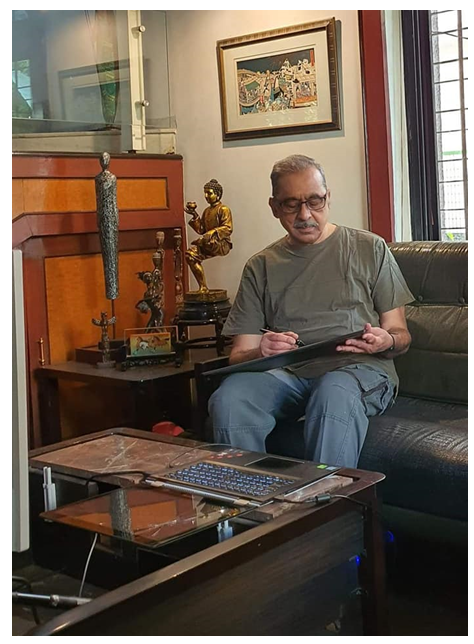
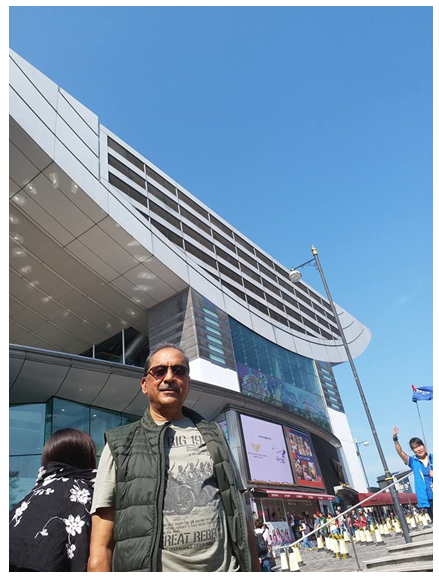
Homecoming
By Saikat Baksi
'Artforms are deeply ingrained in human psyche by nature. All that the artist needs to do is to tap this reservoir and find the gems!’ Says Prakash Ambegaonkar.
But this realization does not dawn overnight. Neither such depth of understanding grows root too early in life. It requires a long walk through the jungle of life for more than half a life. And that’s exactly what Prakash did.
Since he was a little boy playing on the sea beach of Alibaug with his younger brother and elder siblings, he had a penchant for drawing. In the well-to-do household, rich in culture and education, Parkash grew up in a jolly atmosphere consisting of fun and learning. His upright father, a Senior officer in the Police force, stood as a benchmark for an ideal man before the young boy.
The tales from the magazine, Chandamama, captured his fancy prompting him to draw characters from the stories he read.
A brilliant and hungry mind that absorbed anything that crossed its path proved to be an avid learner of math, science as well as painting. The progressive spirit of the family suggested that Prakash should learn something that could feed all his hunger.
And the answer was Architecture. A blend of art, science, and mathematics.
Prakash ventured to graduate as an architect in MS University, Baroda. He recounts a turning point in his life that revealed the secret way of art.
‘Today, I shall give you a special task.’ Said the legendary master, Professor Pingle.
The students waited in eager anxiety.
The master said, ‘Sketch your own figure!’
And Prakash laughs as he recalls what he did. He looks graciously aged this day. But three and half decades ago, he was a tall handsome young man with an athletic body of a long-distance swimmer.
He took measurements of his own body as required and carefully drew a profile of himself on drawing paper and showed it to the master.
The master burst into laughter. ‘Look, this is the reason I told everyone to sketch this. Prakash, you are slim and manly, but do you really have this V shaped body?
Prakash instantly saw the point. He had exaggerated the features of his body like everybody else to impress himself and the master. It was everyone’s ego standing like a mountain between them and the piece of paper! The realization flashed in a blink that an artist can never project the face of truth on the canvas or paper unless ego melts into oblivion.
Even if he took up a well-paying and secured government job after graduation, his desire to set wings for a life of freedom nagged at the back of his mind. Eventually, he flew beyond the border and landed in the US. It was the 80s and the US was trudging through the thick of recession. Nobody accepted him in a senior role as an architect. But giving up was not his way.
Soon he got a break, and his 3D renderings of architectural structures became favorites amongst architectural companies. Eventually, Prakash worked for leading architectural and development firms, but all the time, his fiercely independent spirit got the best of him. Finally, he formed his own company. A dedicated team of architects worked for him building large scale multifamily and commercial projects in California, Nevada and Oregon, USA.
While all this was going on Prakash had charted a map for his future which included his childhood passion of becoming an artist. As an architect he was exposed to many art concepts through study and practice. Compositions, form, space and their intra relationships were second nature to him. While being busy with his professional practice, he began to dig into art history and hence various art movements in the west. Traveling to across the globe exposed him to the works of the masters of the past. During leisure hours, he kept sketching mainly in Aquarelle color pencils. A demanding professional life did not permit him to become a full-fledged artist. Finally, as he had planned several years ago, he closed his lucrative practice, while in great demand, to devote his full time to painting. He boarded the flight back to homeland. He returned to Baroda.
Six years ago, in Baroda, he began to paint again. One day, as destiny had it, he came across the legendary art historian, Deepak Kannal. And he hesitantly showed his works in colour pencil. To save himself from a possible savage dismissal, Prakash said, ‘I do this just to spend my idle hours.’
But the reaction from the legend startled him, ‘Come on! These are not idle scrawls. You can do something to shake the world of art. You have the fire. You can bring some fresh spirit in the stale air of contemporary art in this country. Don’t say that you don’t take art seriously.’
And there was no looking back. His spirit took its flight. One painting followed the other. Eventually, his artworks took the shape of a mix of expressionism and surrealism. An unearthly mood blended with living shapes of people and things.
Recognition came quick. Buyers paid handsomely for his artworks. But still he treasures the valued feedbacks from those who appreciated the finer nuances of art. Money is something he had made in ample amount. All his humble needs were satisfied long ago. It is the appreciation from the true connoisseurs that makes him fulfilled.
The most important takeaway from the life of Parkash Ambegaonkar is the fact, that good art requires a life to back it up. One must live life to the fullest to produce real artworks. He did not practice fine art for almost half a life, but the fundamental ingredients of art were being processed in his senses all the time. That is why when he painted seriously for the first time, it was decades of passion pouring out in raging gusto!
It is a classic example of sharpening the sword for most of the time and then cutting the tree in a single stroke!
Stay tuned and watch out for his next painting if you are looking for a refreshing surprise.
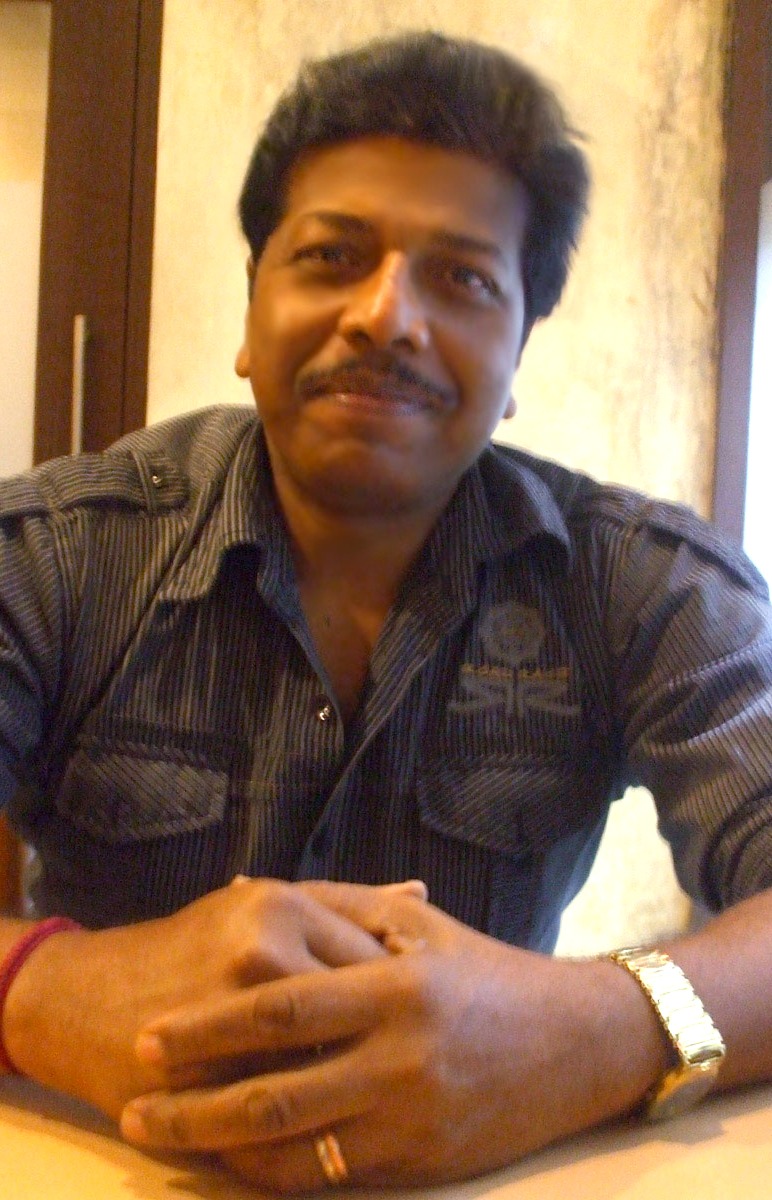

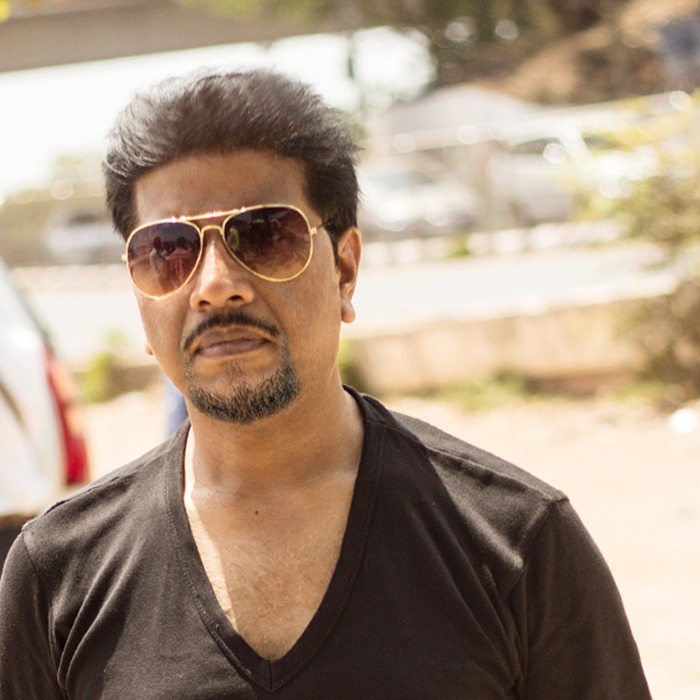
With An Eye on Art
By Meera Srikant
Even before he understood anything about art and artists, Subhash Sharma was drawing in his slate with the chalk. When he drew a monkey in a question paper, he was more excited about how well it had turned out rather than worry about how he had performed in the exam – he was only in class 2 at that time. Of course, his family did not think highly of art as a profession, but the young boy was spontaneous and drew without much thought.
One day when his Hindi teacher was taking class, he noticed the boy drawing. Subhash was asked to come to the front of the class. He knew he was in trouble but went bravely, expecting to be scolded. But to his surprise, his teacher was so impressed with his Bajrang Bali drawing that Subhash was asked to draw it on the board!
His tendency to draw also got him into trouble. One of his classmates misinformed the mathematics teacher that he was not paying attention in class but drawing. The math teacher was upset and though Subhash denied having wasted time, the teacher gave him a beating and asked for his father to meet the principal. The teacher finally apologized; but it was not without making Subhash go through much agony!
Subhash wanted to pursue higher education in fine arts. He was already participating in exhibitions across the world, including Los Angeles, Belgium, Moscow and Dubai. But they lived in Asansol, which had very little facility for an upcoming artist, and the family circumstances prevented his going to Patna to pursue his dreams. He had to complete his BSc from RSP College Jharia, Dhanbad.
Fate willed otherwise. An art teacher from Asansol, later his guru, saw his potential and offered to get an admission of Subhash in the second year in Rabindra Bharati University in Kolkata. This was God-sent and his dreams began to blossom as he pursued fine arts in this esteemed university.
“In 1996, after completing the course, I applied for industrial training. There my dean saw my drawings and on hearing I was an artist, suggested I should start a ceramic design business. But I was not interested in narrowing my art,” says Subhash. His goal was to go to Mumbai to follow his dreams.
He shifted in 1997 and found an opening in an advertising firm. From here, his journey into the arts took a digital turn. While he continued to pursue his passion for painting and also worked on cartoons for the media houses he worked for, he joined an animation company. Though he did not have the necessary training in animation, his skill with the brush got him entry. He had made a flip book which impressed the interviewer. Since then, Subhash not only made great inroads in the multimedia industry but also started his own company, Sketch Multimedia. He is a visiting faculty in several multimedia training institutes such as Arena and Aptech. “Though the course in these centres is for two months, artists can master it in seven days since they only need to learn animation,” Subhash says encouragingly.
During the week, his business keeps him fully occupied, but his weekends and vacations see him spend time with his first love, painting. He brings an artistic view to his multimedia endeavours as well and is involved in film storyboarding too.
Subhash’s works are available online and he also has taken up commissioned work. “But I don’t believe in commercialising my work. Sometimes if someone asks for a portrait, I just draw and give. It brings joy to both of us,” he says. All his works are original, and though one can see the influence of mythological characters, he also likes to paint on contemporary topics. He finds it interesting to draw political figures.
He is planning to start online courses on topics ranging from fine arts, to animation and social issues such as road safety.
For Subhash, art is not just an expression but also something that makes him feel complete. “I am a learner and constantly striving to bring perfection. I am inspired by my surroundings,” he says.
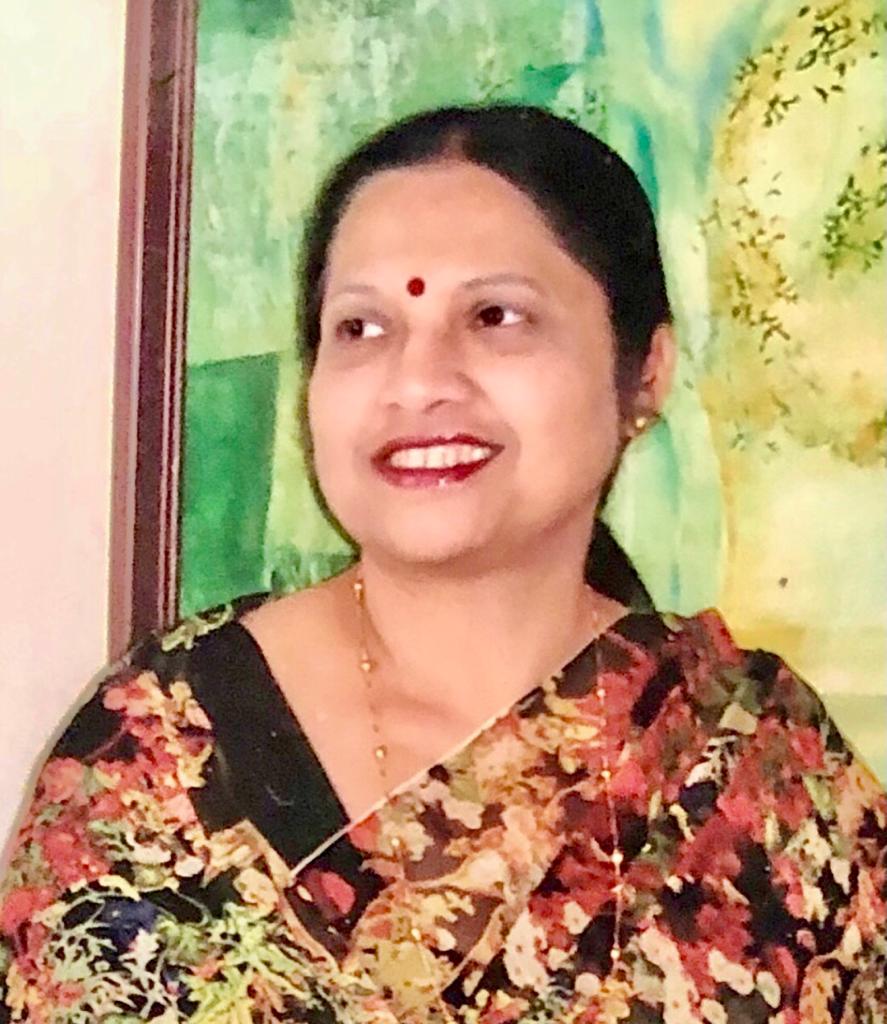
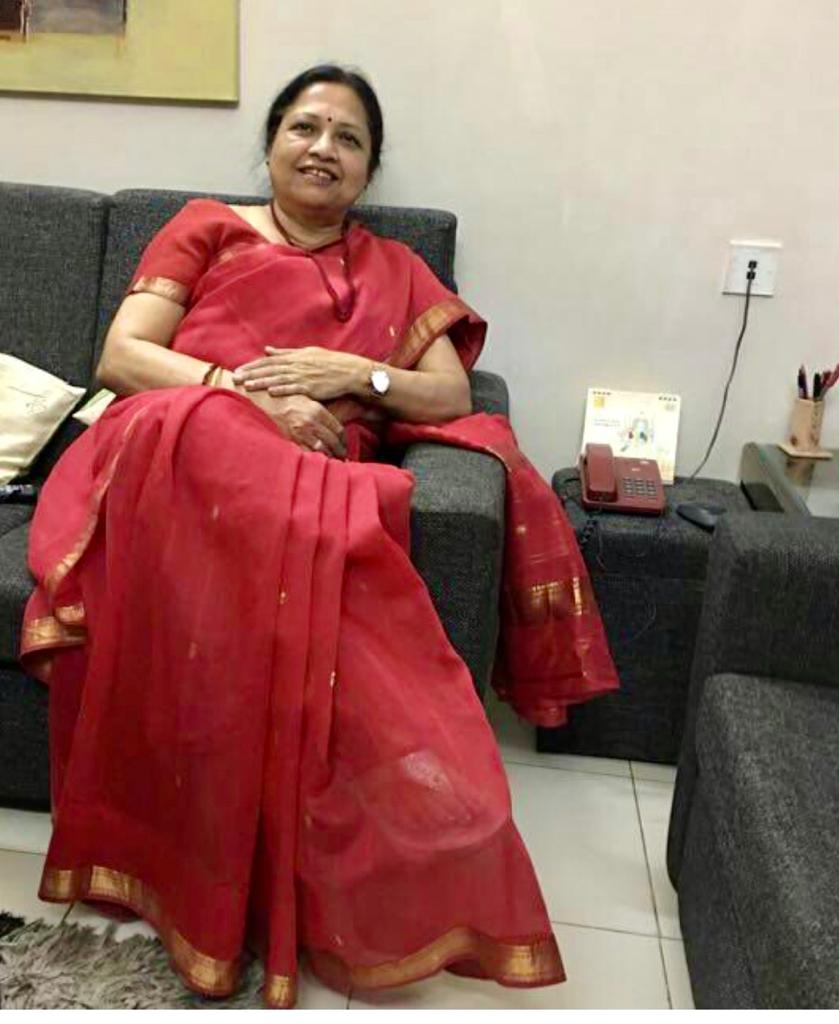
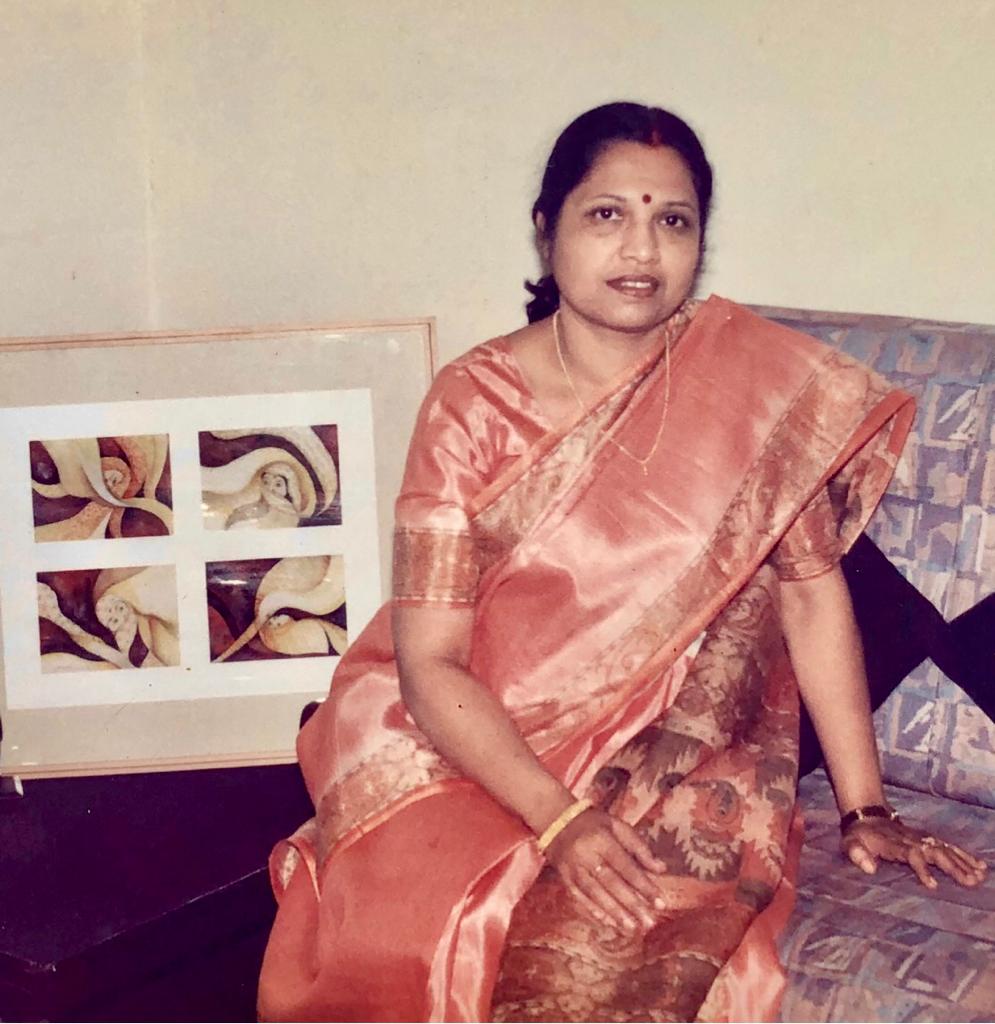
Weaving the Motif of Art into Her Life
By Meera Srikant
She escorted her husband to the hospital for a dialysis often because of renal failure. And with them travelled her canvas, colours and brushes. As she waited for the procedure to be completed, she poured her emotions into her works, painting in vivid colours on themes ranging from nature to social events. It helped her deal with pain then, and when she lost her husband finally to the disease.
Sushma Shrivastava may have become a doctor if she had followed her mother’s advice. She was good at studies and belonged to a scholarly and well-read family. Her mother herself was an artist.
Her uncle was visiting the family when he told her something different. “The happiest jobs are those that involve creativity.”
This truth has borne out in Sushma’s life which has seen ups and downs but helped her remain anchored because of her art and creativity. “Art is like meditation for me. It makes me forget my surroundings. I don’t plan much but let the form emerge,” she says.
Inspired by her uncle, she explored her artistic talent and started painting. Her father worked in the Indian Forest Service in Bhopal and Sushma has grown up and lived there all her life. Growing up, she pursued Master's in Painting, National Diploma of Fine & Applied Arts and Ph.D in Traditional Textile Printing of Malwa in Madhya Pradesh. Soon after, she worked for her brother who ran a unit to make pots by designing for him. Her painting also reflects this style in the motifs she uses. Her paintings are inspired by elements and forms and often revolve around the themes of five elements or motherhood. She loves to experiment and play with colours.
Sushma’s also found a job that was connected to her passion – she was associated with NCERT for 37 years, working in the Regional College of Education. She has set the teaching art and conducting art workshops in Navodaya schools. Since retiring in 2012, she has also created guide books for art education. Now she is also a Guest Faculty in NIFT (National Institute of Fashion Technology) Bhopal.
Even when she was working, apart from helping others find their footing in this creative world of arts, she would paint in whatever time she got during work hours. “We had a studio on one of the floors and I would go there whenever I had some time to paint,” she says
Sushma has displayed her paintings across India, Egypt and Switzerland. Her personal favourite is the exhibition at Jehangir Art Gallery, Mumbai.
Titan had bought one of her works. Impressed with her work, Crompton Greaves bought 30 of her works. She was also given two documentation works by the Madhya Pradesh government and one of her paintings hangs in the school she worked in.
Though retired from active work, there is no retirement from painting. Sushma is also helping poor people by teaching them embroidery and helping them find markets so that they can make a living.
Being a woman, the demands on her time as a wife, mother, daughter-in-law, teacher and so on would have restricted her indulgence in her passion for personal satisfaction. But the calm and collected lady did not let these hinder her creative process. She quietly makes time to paint because that is what is her life blood.



Art for the Love of It
By Meera Srikant
Everyone discusses my art and pretends to understand, as if it were necessary to understand, when it is simply necessary to love. - Claude Monet
For Nisha Sapre, art is an expression of joy. Whether an artist is appreciated or not, she believes that it is what she is born to do. And whether she makes a living from it or not, she must continue to paint.
She chose to do just that. She has no formal training in art. Nisha began to draw and paint since the age of fourteen. Her early forays took the form of greeting cards, and her father’s friend, seeing her work, commissioned her to create cards for his company.
Though she wanted to pursue architecture, she was unable to take it up due to the absence of necessary certification in drawing. So, Nisha pursued chemistry. Marriage took her to Muscat where the time she had on her hands made her turn to art more seriously. In the 1980s, Muscat was just coming up and did not have much to offer—by way of books, art teachers or even materials to work on. She read whatever was available on art and also started painting. She also participated in some group shows.
“My friends liked my work and asked me to teach their children. Seeing my works in the exhibitions, I also started getting commissioned work,” recollects Nisha. Landscape was her favourite theme. When she read a book by Monet, she started experimenting with the form and doing variations.
From Art to Wearable Art
She also came across silk painting when a British artist displayed her work and conducted an introductory workshop that Nisha attended. With that as the starting point, Nisha started trying out designs and techniques on her own.
She did a painting of a date palm on silk and gave it for framing to a shop in Muscat. “I had no plans for it, but I thought I would get it framed. The date palm is a very popular theme in that part of the world, and when a lady saw it in the shop, she wanted to buy it. That was the first painting I sold,” reminisces she.
She has been learning and perfecting the silk to the extent that today, in India, she gets a lot of work for wearable art. Since returning to India 10 years ago, she finds the demand for wearable art to be very high. In addition to that, she also teaches students, and when they pass the exams with flying colours, it is like a personal achievement for her! Some of her students have moved to other countries and continue to learn from her online, validating the efforts she puts in to train them.
Being Inspired
Nisha has also displayed her work at galleries and shows such as Pune Art Festival, Darpan Art Gallery, Cosmos Gallery and Romartika. She tends towards surrealism and likes to experiment with colours and abstract forms.
Every time she paints, she goes into a trance and believes that her works are inspired. “The first time I painted in Muscat, I did not even have a canvas. I did a painting of a waterfall and had been so lost that when I finished it, it was a revelation. As if, I did not paint it, but the painting happened,” she says. To this day, she is amazed at how the paintings take a life of their own as she loses track and has no awareness of her surroundings or the time!
Yes, Monet’s words inspire her. She paints for the love of the form than because it will be appreciated.
Wearable art refers to painting on silk saris, dupattas and scarves. Since Nisha moved to India 10 years ago, this became a rage. Her work is so popular that she keeps getting requests for it.
Interestingly, one of her first works to be sold was also done on silk. It is a difficult medium where getting the right dye is very important to get the desired effect.
But in the end, Nisha Sapre’s paintings paint themselves. The challenges are pleasures for the artist, not hurdles to overcome!
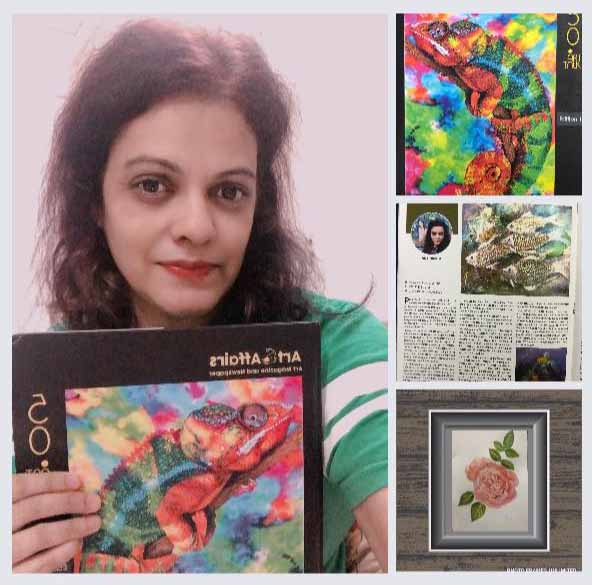
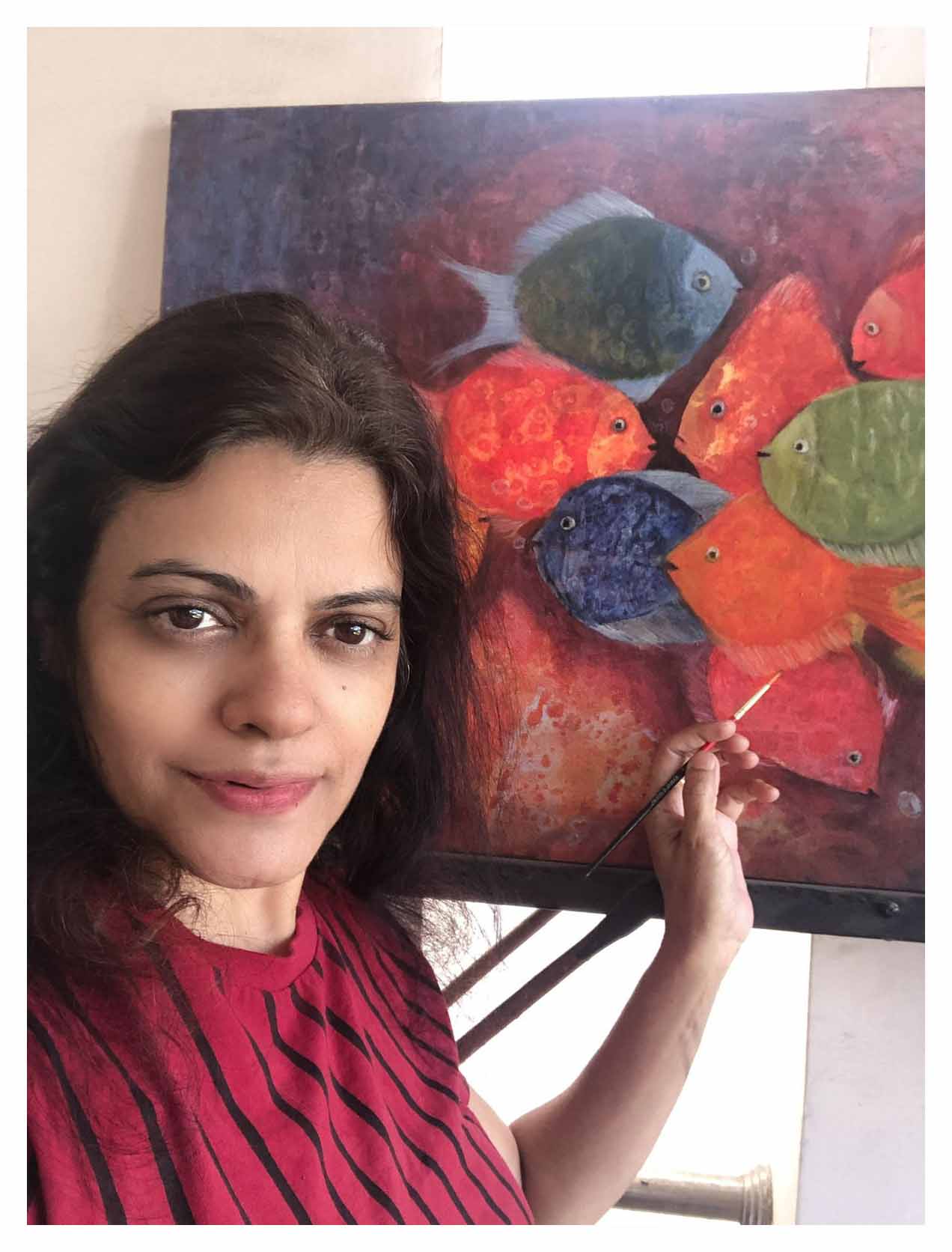
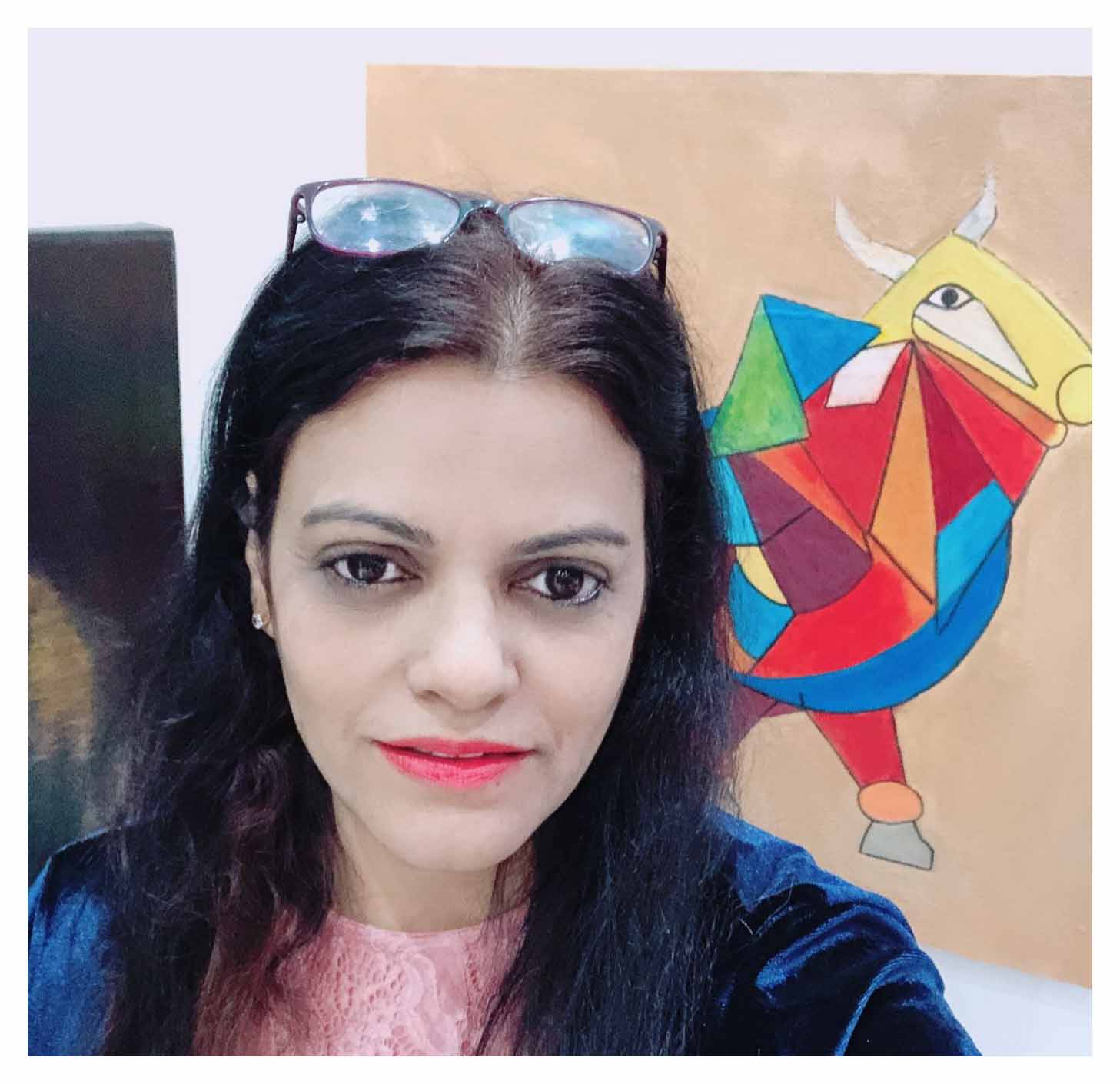
Art is more than canvas and paint
by Dr Amit Biswas
The kindergarten was going through its art session. The teacher noticed something in the mouth of a little girl!
She asked, `Priya, what are you munching?' The little girl opened her mouth to exhibit a lump of clay! On interrogation the child explained in so many words that she loved making various shapes out of clay. What else does a child do when she loves something so much? Tasting it in the mouth to learn more about it!
As she grew up, she learnt how to sketch and draw, apart from making shapes. Family was always a support, though her parents made sure that her regular studies were not adversely affected due to her love of art. Soon she became curious about the role of art in human lives. She realized that published materials are timeless, unlike the digital platforms, which drown under Petabytes of information. Though available, accessibility becomes remote. But still there in no escape from the digital world. Only an optimum combination of online and offline inititaives can be truly beneficial to mankind.
That's when she turned into an entrepreneur. Naturally, she chose the field of art. Her online art forum is a popular platform for artists and art lovers. She published a few books of art from assorted artists. `My passion for art helped me connect with other artists' Priya explains.
Exhibitions and awards are ways to bring talents to the fore. Artists and art lovers reach one another. Priya aims at the success of ART rather than success of few artists! That's where, Priya turns out to be philosophically unique.
Her philosophy is her motivation apart from the admirations she received from time to time from her viewers and fellow artists as well as art forums. Priya believes that the world should become aesthetically more beautiful a place and art need be the vehicle for that mission. Art is a stress reliever and can replace addiction to substances. Priya believes that education in art may not be a necessity. All one needs is to express themselves on the canvas through colours.
In one of her websites, she conducts art workshops and exhibitions in collaboration with the UN Global Conversation project, where artists deal with an issue that the planet is facing, to enlighten the viewers. Pollution, global warming, deforestation etc have been the themes thus far. Effect of pandemic on art is a concern of her endeavour.
Her ancestors nurtured passion for art but did not pursue with such devotion as Priya does. She is the first artist in the family. Her nuclear family today pursues music and sports, and she is the flag bearer for art. Priya is concerned about the invasion of technology into the lives of children. She feels that children are losing their creative spirit due to their too much involvement in gadgets.
For her, classical Indian Values are of utmost importance. Hailing from Andhra Pradesh, having had her schooling in Orisa and having lived in Karnataka as well as Maharashtra, she calls herself a classic Indian who tasted the charm of every corner of the land! Unlike many other artists, Priya Yalaburi is not restricted to the canvas and paint alone. Her endeavors are meant to connect human values and social issues to the artists and art lovers seanlessly. The nation has a lot more to benefit from Priyas myriad initiatives.
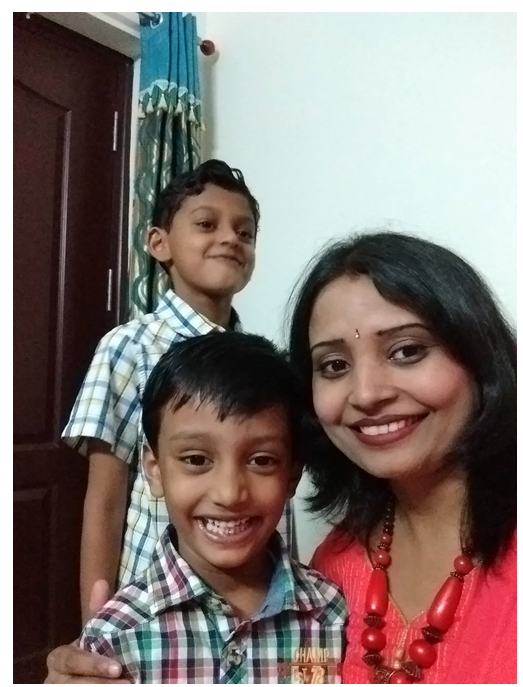
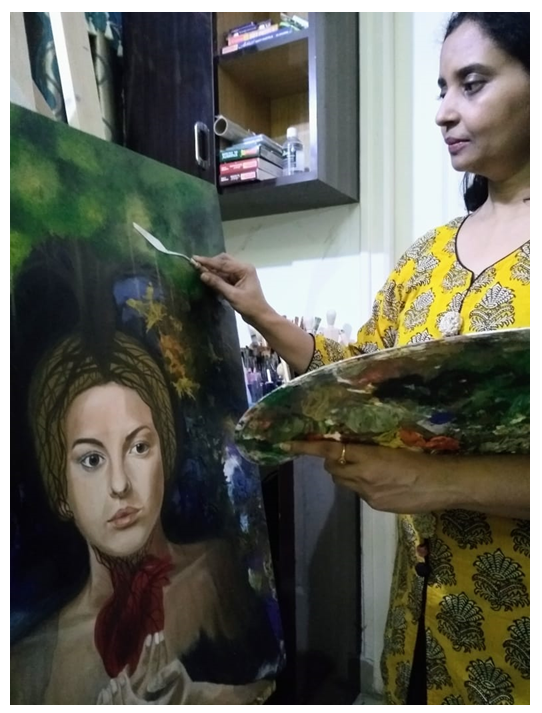
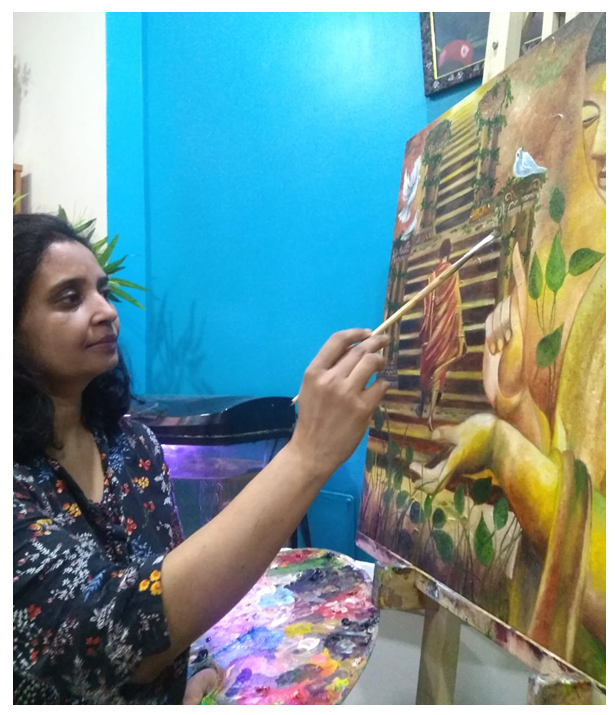
Sketching Out a Future in Painting
by Meera Srikant
Like most Indian children, for Priyanka Patel too, art was denied as a career option when she was young. Since she had the talent, she had permission to indulge in it as a hobby. She did pencil sketch and water colour when she had the time. But as she pursued her doctorate in botany and then a career in teaching, where was the time?
Marrying and moving to the US changed all that. As a bored housewife, time was ripe to take up painting again. Interestingly, her husband already had bought brushes and colours for he too was interested in painting. But much like Priyanka, he didn’t find the time to use them. Now they came in handy and Priyanka found herself reviving her passion and skills.
One of their friends saw her works and, impressed with her talent, inspired her to conduct an exhibition. This also encouraged her to develop her skills further and she referred to Google and YouTube to sharpen her skills. “The Internet is like a university and can teach you much,” she points out. She learned to work with acrylic.
Striking a New Path
In 2009, the couple returned to India and the family expanded as she had two beautiful sons. When the second child was a year old, she decided that she must resume and started to manage more time for painting. She began to teach painting in 2013 to the children in her neighborhood. It was received well and today she has more than 100 students. She also continued to hone her skills and in 2019, she joined Kala Nirvana classes online for a year but dropped out subsequently.
Since 2015, Priyanka picked up oil as her preferred medium. She was more into realism earlier but now she is leaning towards modern expressions. “My themes revolve around my life, my realizations, my problems, solutions and my perspective. Art should not only present the problem but also reveal the solution,” she believes and is striving towards attaining maturity in expressing them well. She adds, “I love abstract paintings, I am fascinated by it. One must develop one’s own style instead of repeating history on canvas,” she adds.
Coming Out
A shy person, Priyanka had kept her creations away from public eye for a long time. But since 2019, she has been participating in exhibitions and soon she started getting commissioned works. Most of them are in charcoal and graphite on large frames of 2-5 feet for interiors. “I am very happy to execute such commissions, but I am not happy with the process of selling. People must be made aware of the value of art in one’s life and not view it merely as decoration,” she points out.
Some of the exhibitions, she has participated in, include Awadh Art, Lalit Kala Akademi in Delhi and Kolkata, apart from 60 others online and offline shows.
“I can see my evolution and, I am sure, in the next 2-3 years, I shall evolve more,” she says with confidence. She firmly believes, “Whether you go for realism or abstract, let your paintings tell a story.”
Priyanka says, ‘When one is passionate about something, finding time is not an issue.’
Now she draws and paints for 6-7 hours every day, using mundane objects and people around her as inspiration. After all, passion knows no bounds.
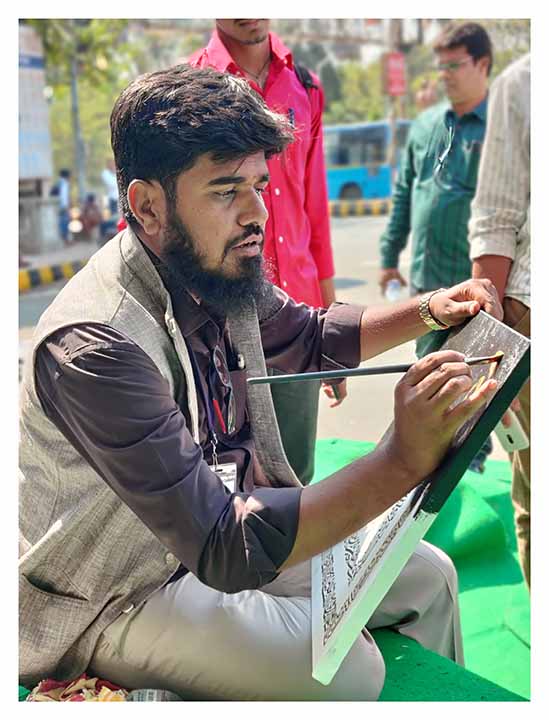
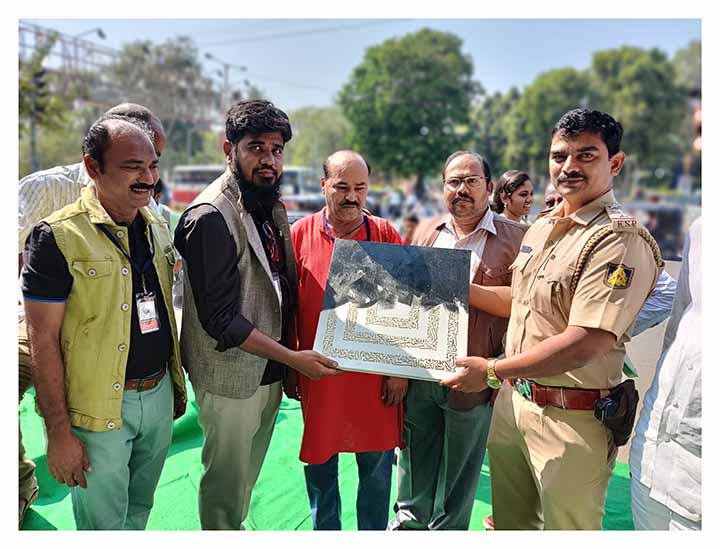
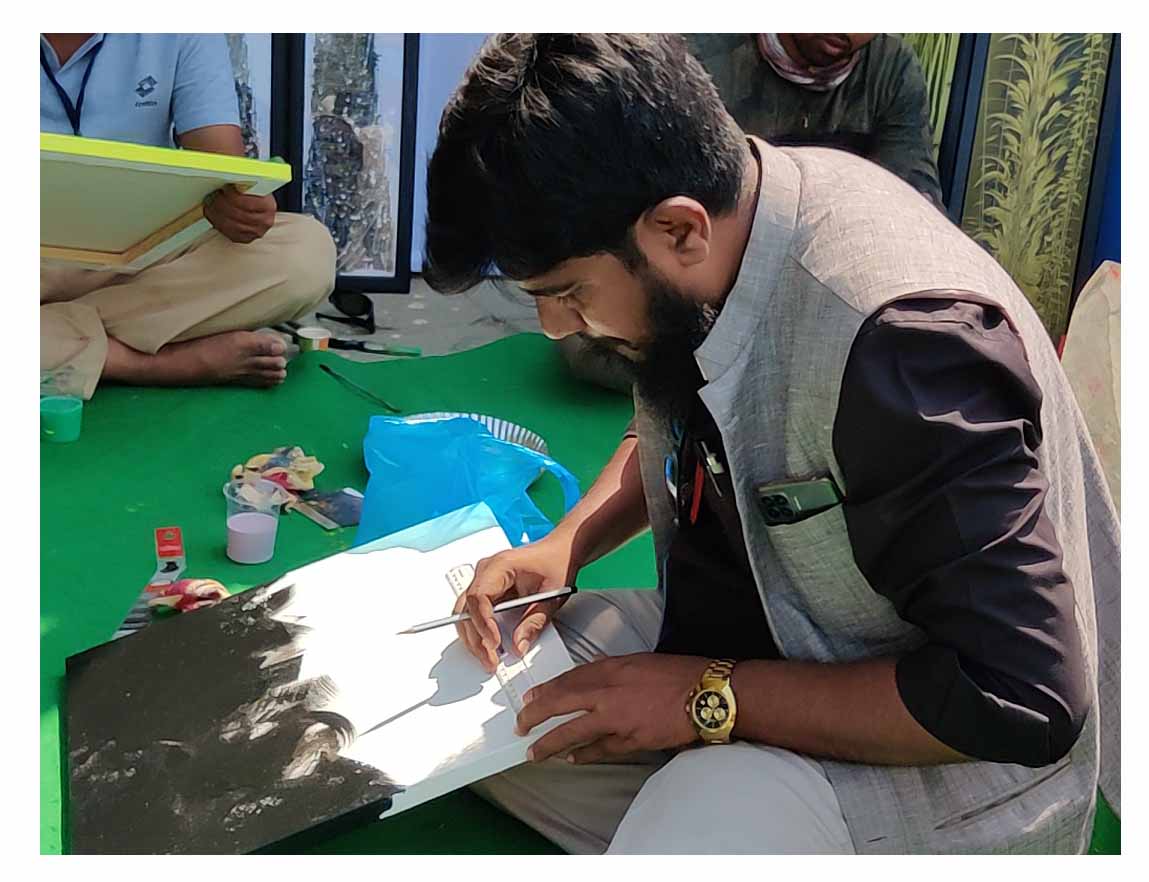
A RARE ARTIST - HAPPINESS PERSONIFIED
By Dr Amit Biswas
Meet this happy artist lending credence to the adage, 'happiness is a state of mind'.
Shaikh Ahsan was born in a family of artists in the small town of Gulbarga. His grandfather and uncle were commercial artists supporting family through their work. Shaikh inherited the passion and started helping them when he grew up.
Then after finishing his tenth, he expressed his desire to study art and met with resistance from the family. His father, working abroad, said, ‘Our family of artists are struggling to meet ends. I want you to study Engineering. Hence you better stick to science."
Shaikh joined and completed two years of science with no great scores to aspire for Engineering. He began to work more closely with his uncle as a commercial artist to meet the financial needs of the family. Then eventually his father agreed for his education in art. This time he scored well and secured good ranks but continued to work in the confines of commercial art. He finished his masters too.
To further his education in commercial art he joined arena multimedia in Hyderabad but struggled to pay fees and had to take too many breaks. During such breaks, Shaikh began doing calligraphy without a formal training and discovered later that his style was close to those from Iran!
While exploring the nuances of the art of calligraphy, he developed a few connections in the middle eastern art-world!
Feeling claustrophobic as a commercial artist, he looked for jobs, first in the middle east and later close to home in Bangalore. From designing graphics for an ad agency, he switched to pharma industry to illustrate their product.
The routine life of pharma industry tired him soon. He shifted job again. This time it was an event management company. But the world of glamour repelled the devout Muslim. The recession was also lurking round the corner.
That's when he travelled back to his hometown and became an entrepreneur in the signage industry. In about eight years' time he became market leader in his town. The success allowed him to consider the intellectual need of his mind. Few exhibitions and the TikTok app encouraged him to get back to calligraphy and he hit almost instantaneous popularity in cities away from home.
Fusion of his experience in commercial art, calligraphy and Persian art lead him into Nastaliq art form. He began to enjoy popularity in Iran. A small forum of artists at home too helped him with those exhibitions.
That's when he landed up on the Romartika platform. Then a day came when his friends and well-wishers goaded him to participate in an art competition online. He gave wings to his imagination in calligraphy. Without much of hope or expectation, Shaikh, now the satisfied businessman, entered the contest. And to his surprise, he found himself among the top rated artists.
The happy man was happier now.
His art found buyers too in Romartika during a virtual exhibition that was widely covered in the media. "Romartika is doing a very unusual and unique service." Shaikh is surprised and very satisfied with the transparency Romartika maintains.
The vagaries of life never dampened his spirit. He headed for his destiny with his head high. Shaikh enjoys the spirit of the vibrant family he is gifted with. He believes he is the 'chosen one'.
As a whole, the artist is an embodiment of happiness!
Shaikh's paintings can be seen in the following link (Romartika's painting section)
https://www.romartika.com/Romartika/paintings-gallery?artist_name=Shaikh+Ahsan
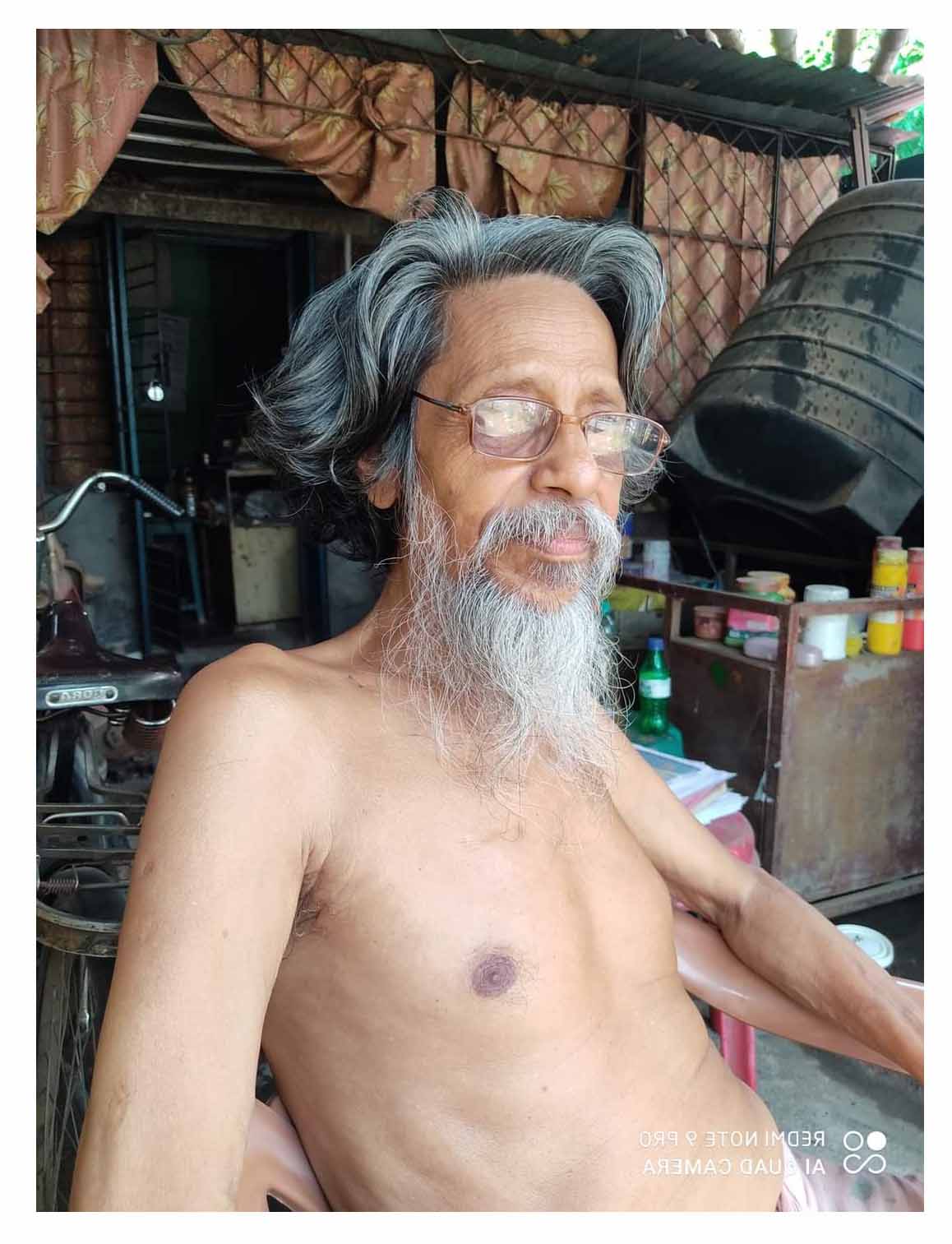
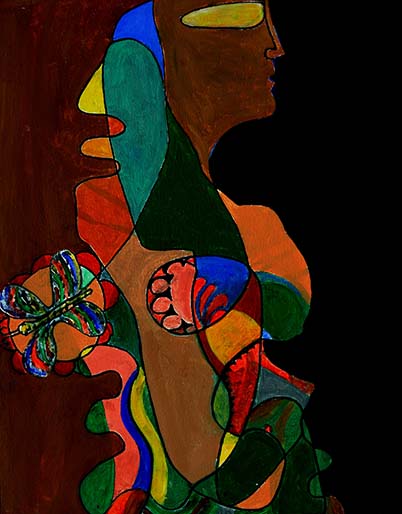
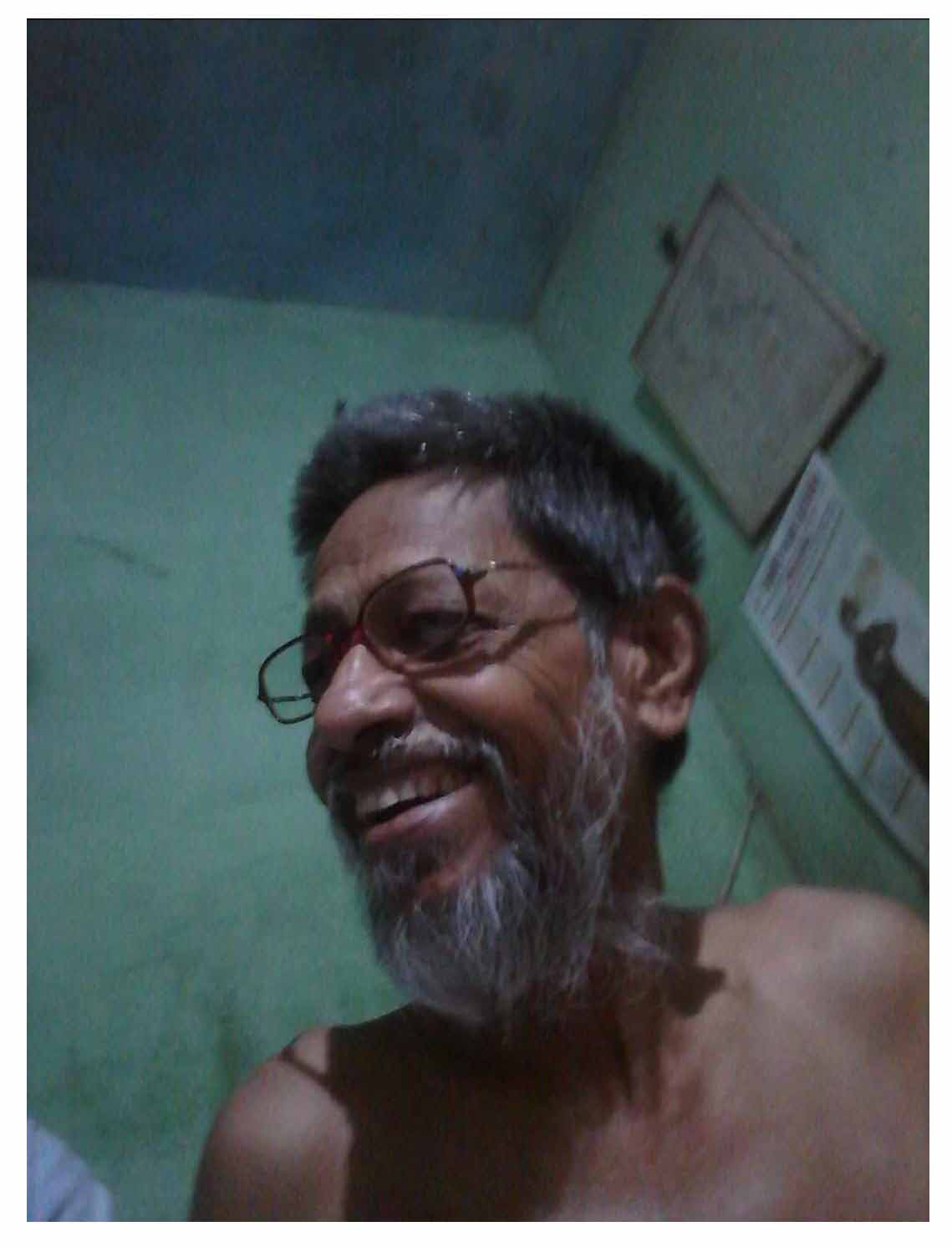
I don't know any grammar; my guide is the cloud!
By Saikat Baksi
I found some strangeness in his paintings. In fact, the simplicity and freedom in applying the paints on the canvas stuck to my mind. In the beginning, the images appeared childish. But more I looked at them, a saying of Picasso came back haunting, ‘Every child is an artist, but the challenge is to remain so while growing up.’
Munikesh Sil is one of them.
When he took my call, I introduced myself. He responded in excitement with a brief incredulous laughter, ‘Sandeep says that you want to interview me! I am shocked. In the past seventy-six years, nobody did such a strange thing!’
He was happy. Of course, he had that humble pride that he knew what art was. Be it unseen by most people in the world, yet. He knew what gem was hidden in his riot of colours.
I asked about his childhood days.
Proud of his father, the artist said that his father felt sad because often he could not afford the textbooks for the son. The Maths, or the science books. But the artist as a child used to keep crying for just two things. A drawing book and a pencil. The rest of it was dull for him. Of course, the wandering father driving army trucks in Burma could somehow manage to provide the basic requirements for the education of his child back home.
In the school, most of the teachers naturally found the boy devoid of promise, except the art-teacher who was a veteran and a disciple of Nandalal Bose. One day, when Munikesh was perfecting the shape and size of a face on the paper, the veteran said, ‘You want to paint exactly what you see out there? Then go, get a camera. Do not waste time wrestling on the paper. And if you wish to paint the pain, pleasure, hope and agonies of people, pick up the pencil. Those are rarely captured by the camera. A smiling face is not always the testimony of absence of tears. Camera fails there. Art begins.’
Thus opened the mind’s eye of the artist.
‘Did you go to art college?’ I asked.
He wanted, but could not, because there was no money.
‘And then?’ I asked.
‘Those were the days. Naxalbari was the talk of the town. The land was on fire. Revolution raged through every nook and corner. I became part of it, naturally. And soon I was frequenting the jail. It was the jail that offered me plenty of recess to reflect and study the utility of the revolution. And I realized that the revolution did not make a lot of sense.’
But that realization did not help him much beyond a change in his views. He was already branded as a hard-core Naxalite who perhaps threw bombs or fired bullets or killed bourgeois. In reality, he was an artist who could never even kill a mosquito with ease. His weapon was the brush and paint. Not guns.
He decided to fulfil the gap in his formal study of art by visiting Shanti Niketan. Ramkinkar Baij fascinated him. The unruly ruggedness implying the impudence of nature in Ramkinkar’s work captured his fancy. Munikesh realized again that the reality hides way below the layers of skin.
But all that realization did not pacify the pinch of hunger. He needed a job. He also wanted a family – a wife and a baby someday. Thanks to his artistic genius, he could visualize the awkward twists and turns in the shapes of the elements of machines. He tried his luck with engineering companies, one after the other. But the Naxalite stamp and his history of paying regular visit to the prison turned into a stumbling block. His applications were rejected swiftly. But eventually, fortune smiled. He joined Hind Motors. The good fortune did not last long. The same cause made him jobless soon.
‘Did you not get another job? How did you survive then?’ I asked.
‘It is strange, but I worked on contract basis for many big companies. Punj Lloyd, Sriram EPC and a few more. After all I wanted to marry too, you see! And I did marry at the age of forty-five. She was from the village and a wonderful lady. I am fortunate. I got a son too.’
He reflected with slight sorrow, ‘You know, I could never get one thing in life. That is money. It is not a big problem though. Life never stopped because of its absence. When my son was a young boy, he would be insisting on eating Hilsha Fish daily. I would go out to the market to get one piece of Rohu which was way cheaper. My wife would cook for him. He would savour the fish and tell everyone in the locality that he had Hilsha. My wife and I would eat the regular menu of dal and rice. But the boy would be happy.’
‘Despite the perpetual crisis, you painted. Right?’ I asked.
‘That is the interesting part. You see, I could never paint well when I held a job and received salaries on regular basis. My paintings came to life when I had sorrows and sufferings. Of course, crisis had always been the most loyal buddy of mine.’ He laughs.
‘And you could afford the paint and canvas?’ I was curious.
‘No! How could I? The fire in the kitchen itself was flickering. Where was the the luxury of buying paint?’
‘Then?’
‘Oh, I thought you are aware. Sandeep kept providing me with canvas and paint whenever I was low in spirit. I am fortunate, you see! Once he even organized my participation in a group show. I was thrilled but later I realized that I was a misfit. I do not know any grammar of art. I do not know the ways of the elite world. How could I fit into such assembly of artists and visitors?’
‘But does grammar matter a lot?’ I objected.
‘It does not matter to me. But to people it does. I once painted some Tribal women. They look so happy and brimming with life. They are beautiful, you know. To capture their wild spirit, I painted them yellow. And an art connoisseur grilled me for that. How the hell did I paint tribals in yellow! Maybe, I flouted some grammar. But then you know what? I think, not the genes but the convention and protocols will never allow a tribal woman to be fair-skinned.’
I asked him, ‘So, do you follow any rule or guideline when you paint?’
He burst into laughter again, ‘It is simple. Look at the sky. Keep looking. You will find the clouds forming myriad of shapes every now and then and breaking themselves into pieces to form another shape again. What could be a better guide than that? An artist cannot be separate from the nature. An artist does not have to subdue nature for the sake of canvas. Artist should be synonymous with the nature. Does nature need a training to be what it is? Same applies to the artist. Artist does not need a training either.’
He paused for a moment and said, ‘I tell the young children that they should keep scrawling. Now they will find a flower emerging from the scrawl, then there will be a bird flying out of the jumble of the scrawl. Who knows? Do not try to capture the bird or the flower. Let them appear as they wish.’
On second thought, Munikesh said, ‘You know, the crisis pinches at times. During the rainy days, water seeps through the cracks in the roof and the walls. I can not afford a good meal, let alone repair. Maybe, my son will get it done some day. But then you see, there can not be sunny days throughout the year. There will be rain too. I try to enjoy the rain under my roof. Everyone does not get a chance.’ Munikesh laughs again.
His laughter is not bitterness. It is not smirk. It is sincere expression of happiness and acceptance of life as whole. He asked if the interview would be published somewhere. I told him about our platform. He was worried. ‘How can I see? Mine is not a smartphone. It’s a thousand-rupee handset. I shall then ask one of the neighbours to show me. Not a problem.’
After I finished taking to him, I felt a little sad. Not for him. But for me. Despite living in a nice house without any crack, and eating two square meals a day, I could not laugh like the septuagenarian did.
Perhaps even after living more than half a life, I am yet to learn to accept life as it is.
-------------------------------------------------------------------------------------------------------------------------------------------------
His artworks can be seen in the painting section of this platform. Please click on the following link -
https://www.romartika.com/Romartika/paintings-gallery?artist_name=Munikesh++Sil
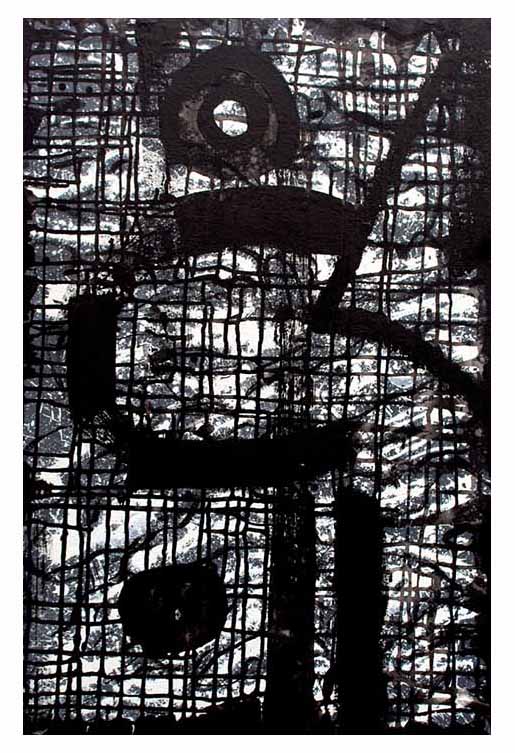
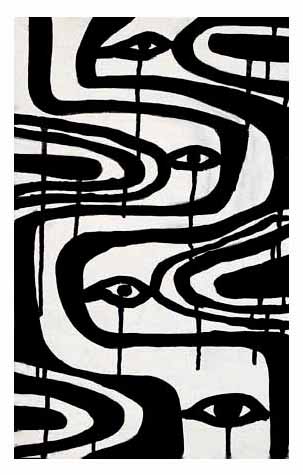
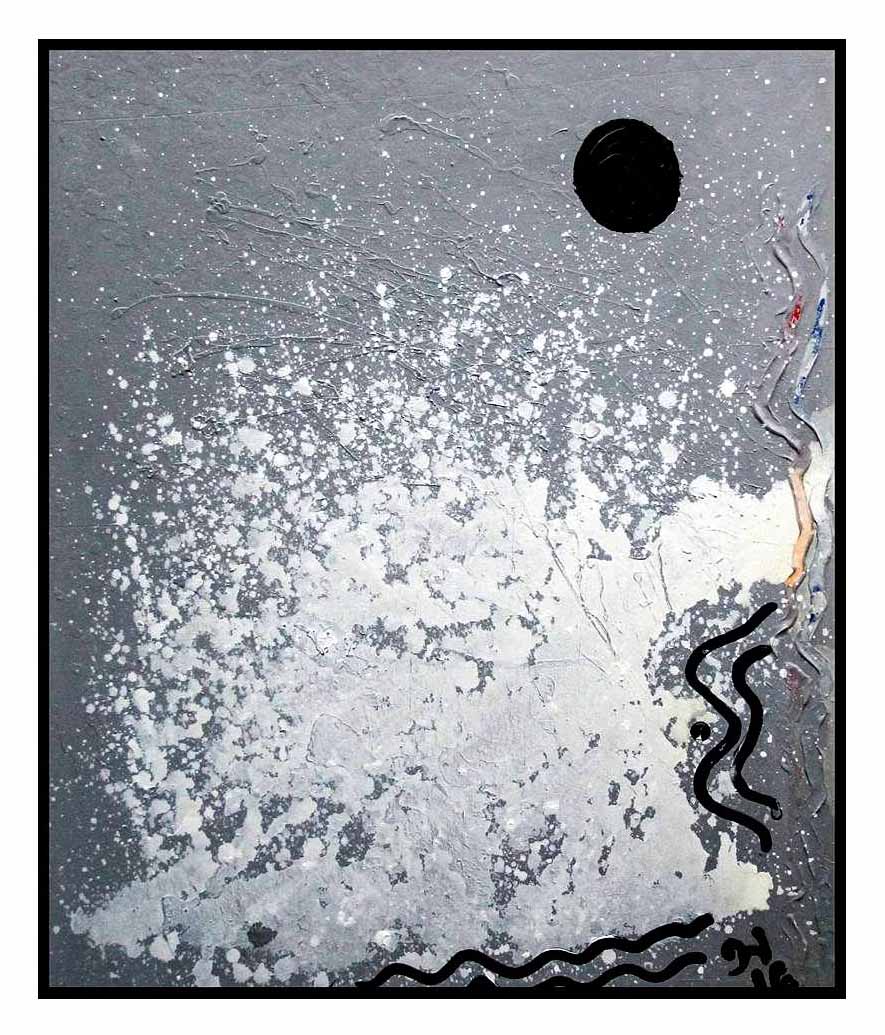
THE PORTRAIT OF AN ARTIST
by Pooja Sonkar
‘Indianness’ as a philosophy is what artist Sandip Roychowdhury is all about. To him creativity is an inevitable act of existence. It is not merely for commercial consumption but for oneself. Even the simplest act of wearing a saree, is an art-form by itself. He calls, living by this virtue, to be ‘The Art of Living’, a balance between action and inaction. Embracing simplicity and humility as his lifestyle, he believes in celebrating the little things. He talks about how learning is a slow and expansive process in Indian tradition where one qualifies over decades to become the master.
Born in Halisahar in 24 Parganas, Sandip has grown up enjoying the quiet bliss of the Bengali countryside, feasting on fish and fruit from his own estate. An ancestral home complete with a beautiful lotus pond is a backdrop to his artistry.
His works are a dialogue of black and white. An amalgamation of themes from both sides of the border, he is a libertarian at heart. Although he doesn’t care much about the distinctions of religion he focuses his energy on spirituality.
The youngest of four siblings, he maintains within himself the purity of innocence. For him it is the most prized quality. Untainted simplicity, devoid of malice, greed, and arrogance, forms the core of his artworks.
In his younger days, the Baul Mela held at his maternal uncle’s town Birbhum left a great impression on him. He became a ‘Bengali Literary Worker’ and a seller for ‘The Little Magazine’. It was during this time that he was inspired to write and share his poetry with his friends. To his friends’ amazement his work was a hidden gem. Eventually the poems appeared in the aforesaid magazine. His compositions and recitation were highly appreciated. Gifts poured in as cups of expensive wine. Haze of cigarette smoke infused with the nausea of luxury and success clouded his childlike eyes from the unpretentious life he once valued. Then one day he decided to leave it all behind. With the passage of time his yearning for purity of passion took over. A general disappointment with human nature caused him to withdraw and only write for himself.
He is affected deeply by the concepts of clarity and purity which are reflected in his experimental works in pure whites, blacks and red and the colours in between. His emphasis on clarity and discretion can be seen in the way he plans his artworks.
Just like the institutionalised education he doesn’t hold in high regard, for their mechanical methodology, his works rebel against standardized symbols. They exhibit unpredictable, shapeless abstract forms for psychological and therapeutic healing.
Brought to tears by the works of Ritwik Ghatak, he says that the source of all creativity is the same. That the expression of the artist, is not the medium but the message within the artwork itself. Be it film or painting or photography what an artist has to say has more bearing than the technique itself.
He feels empathy for the artists from all over the subcontinent. Impartial to peoples beyond political borders, he hopes to unite them through his residency which is currently in a very nascent stage. He is open to artists and craftsmen from countries with a similar South Asian culture from Pakistan to Malaysia.
One of the most interesting things about Sandip is his compassion for struggling artists. It is his mission to groom and provide assistance to aspiring artists who have no access to art materials. Having undergone the same struggle himself, he empathizes with the needs of others like him. Currently with four artists under his wings, Sandeep hopes to be able to help hundreds who need not grapple with the vagaries of life in order to survive.
Note – Only in this story, we made an exception of not showing the photograph of the artist because the artist himself requested that his face must be his art works, not his eyes, nose and lips!
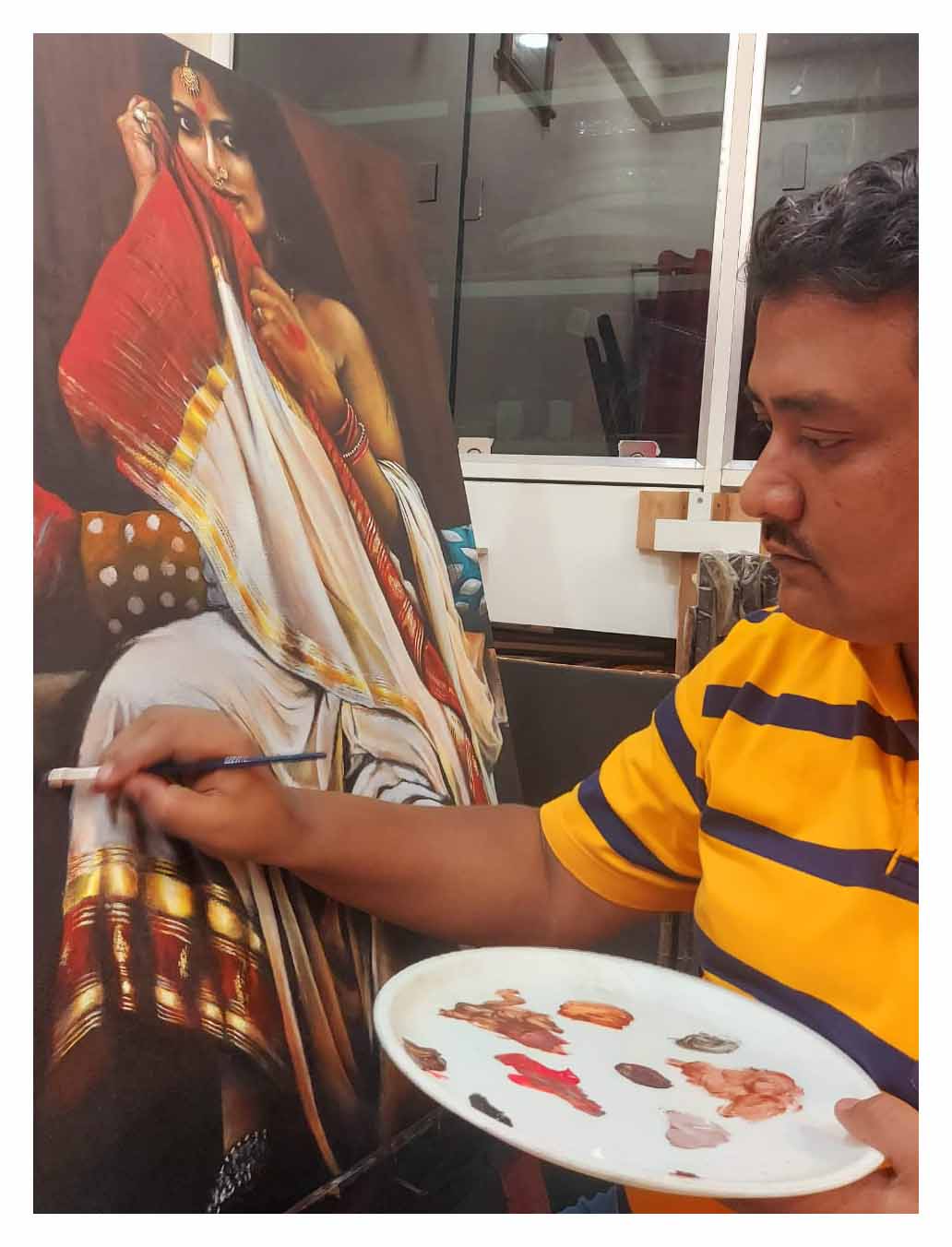
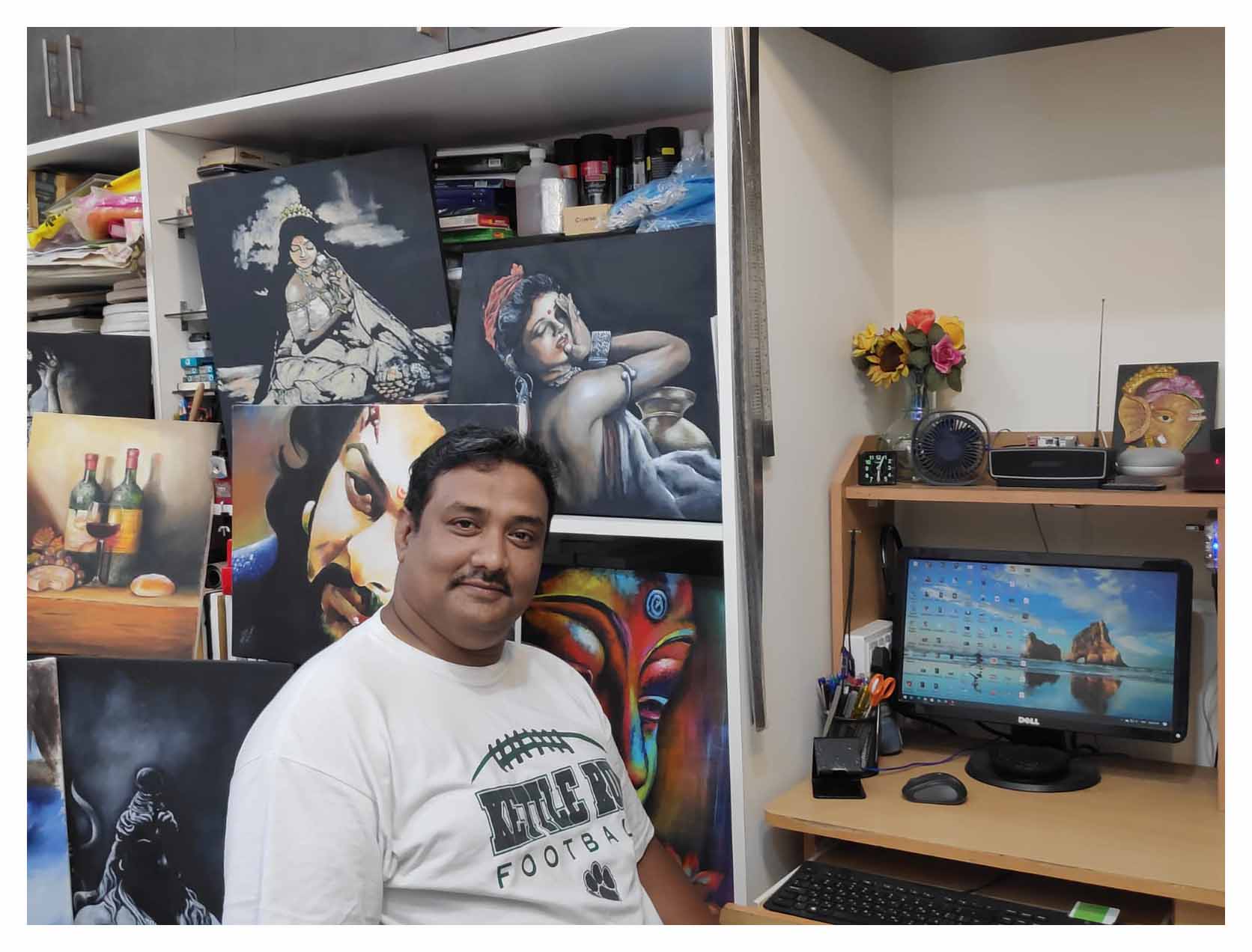
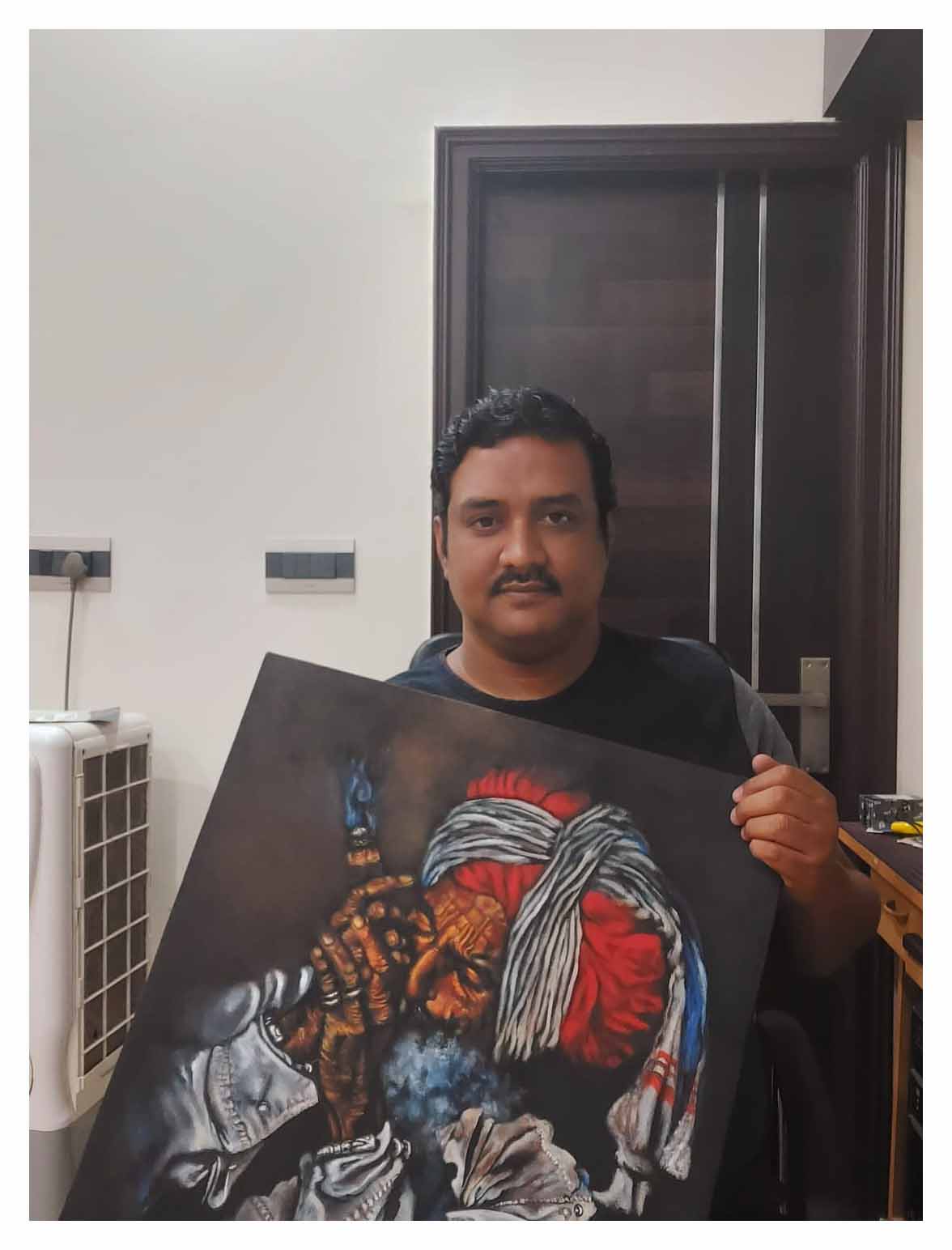
Once an Artist, Always an Artist
By Meera Srikant
The expression in the eyes of the beautiful woman sitting on the cot with the pallu of her saree between her teeth is seductive. It invites you into her world of mystique and romance while her smile magnetically allures you with promises you cannot turn away from.
Welcome to Sigma Arts Gallery that displays works by Manoj Swain!
A few years ago, Swain’s life was on an entirely different path. Though as a child, he had been natural and effortless in creating arts and crafts, he had to leave it behind. “Since we belonged to the lower middle-class family, my father was unable to get me the materials needed to pursue art seriously,” recollects Swain. He studied chemical engineering, and during the course, his talent came in handy while drawing the diagrams and flow charts, that he infused with colour and imagination. Currently employed in Credit Suisse Services, Bangalore, he also found an outlet in writing poetry.
With a nice family at home, his life had all the trappings of a successful man. When his daughter was just 2 or 3 years old, Manoj Swain noticed her artistic tendencies. She tended to use whatever material she could find to create something beautiful. When she turned 4, he sent her to an art school, but seeing they were unable to hone her skill in any constructive way, he took her out and they watched YouTube videos to get her started. He got her small canvases to draw on—he had to depend on the stationery shop owner to tell him what materials he could give his daughter to draw and paint. In the process, his own artistic skills that he had not paid conscious attention to, came to the fore.
Yes, his daughter rekindled his passion for drawing and painting again.
In 2018, he tried his hand at landscape painting on one of the small canvases he had actually bought for his daughter. It did not come off as good as he expected but was good enough to reassure him that he could still paint. He had been so removed from the world of arts that he didn’t even know about the well-known artists in the field, except two or three. He managed to find YouTube videos by a couple of landscape artists such as Kevin Hall and U.V.N. and reentered the world of painting.
“Many told me that this was obsolete and that I was getting monotonous. It was disheartening,” says Swain. So, he turned to spiritual topics like Buddha. But even this didn’t work out the way he hoped. Then he learnt about the use of shadow effect to give his paintings depth, which was a turning point in his artistic journey. At that time, he came across the Instagram account handle, ‘Iamzulf’, where he learnt about the use of black canvas. This was another turning point. It elevated the effect of his paintings, enabling him to explore colours and expressions.
Swain’s paintings are a veritable interplay of emotions and expressions. “I look for inspiration in photographs, but not the usual, posed ones. Expressions matter to me. I want it to tell a story,” says Swain. And stories they do tell, his paintings. There is one of Radha Krishna, where Krishna is playing the flute, but instead of Radha seeming lost in the music, you can she is sad. This is the last time they will be together and after this moment, Krishna will never play the flute again as she will break it.
After three attempts, this was the first year, Swain’s paintings got accepted for being displayed in the online exhibition conducted by Karnataka’s Chitrakala Parishath. Though he gets lots of feedback, he also gets lots of enquiries for his work and he has sold a few too. This is encouragement enough for him to continue to find that unique something to paint. Once the pandemic is over and normal life resumes, he hopes to train other youngsters in painting at no cost. “I had no formal training, and I want to help others with the inclination and capability to learn the fine art of painting. You can only teach the techniques, but capturing the unique is a very individual capability that each one must develop on their own,” he says. One has to keep observing and absorbing all that one sees, he adds. This is evident in the way the women in his portraits come alive. For Swain, learning from life and transferring it to the canvas is the way to constantly improve his skills and the quality of his paintings.
Art lovers will look forward to new frontiers in realism through his canvas in the coming days.